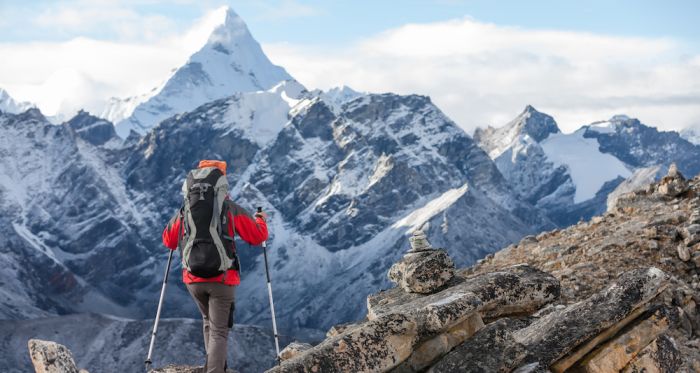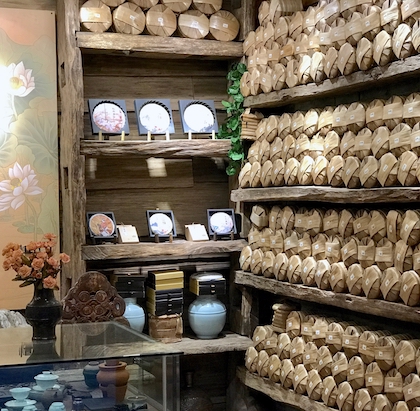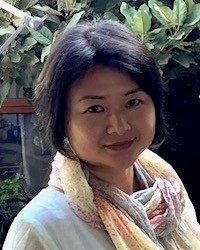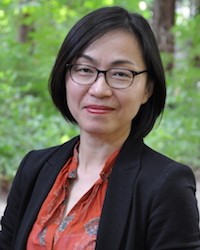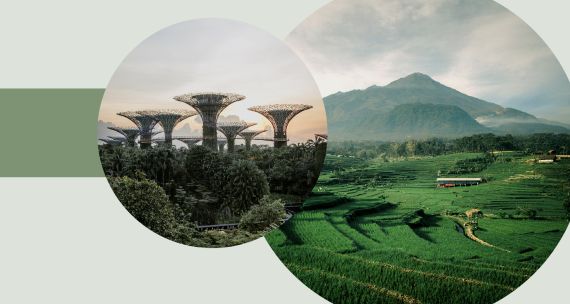Introduction
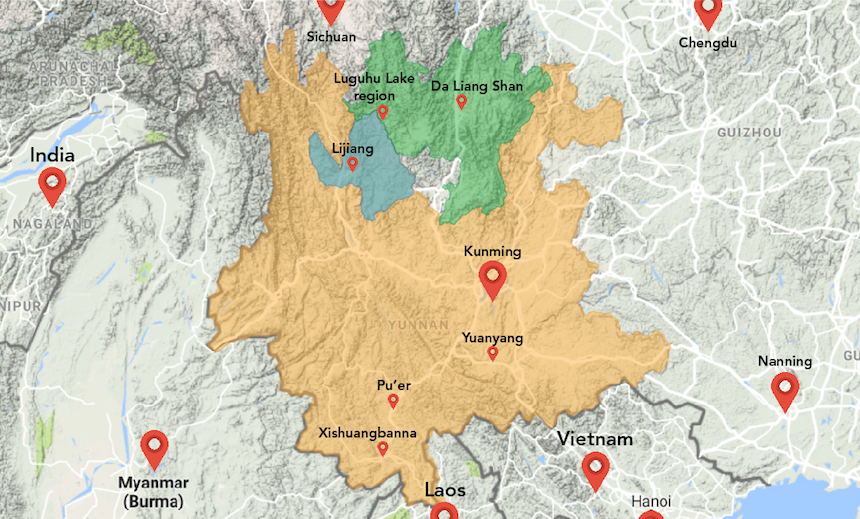
Join us for a virtual field trip to the frontier lands of remotest China! UBC Political Science Professor Yves Tiberghien, along with his writer/lecturer wife Yvonne Xiao Tiberghien and China experts Professor Dayuan Xue (Minzu University of China) and Li Guo (UBC Ph.D. candidate), visit four regions on a field-research mission over three years.
Join the team as they share field observations, interviews, analysis, and photographic reports from four regions:
- The Da Liang Shan Region: Land of the Yi people, visited in January 2018. Exploration in this region reveals an amazing richness in biodiversity and traditional Indigenous knowledge in the midst of hard work to eradicate poverty and bring renewable energy to the poorest counties of China.
- The Luguhu Lake Region: Land of the Mosuo and Yi, visited in August 2017 and January 2018. The region boasts some of the most pristine lake ecosystems and beautiful mountain parks in Sichuan, along with rich Indigenous knowledge and culture. These areas are at the forefront of an effort to combine eco-tourism, environmental protection, and some measure of wealth and recognition for local Indigenous people.
- Lijiang and the ancient Tea and Horse Road: Visited in June 2015 and September 2017. Lijiang is on the UNESCO world heritage list and one of best preserved ancient cities in China. It is the hub of the ancient road linking Tibet with Southwest China and Southeast Asia, as well as a modern hub of ecological and cultural tourism in the region.
- Protected natural reserves and traditional knowledge research in Yunan: Visited in June 2015. In this region, various models of biodiversity protection are being tested along with new efforts to recognize traditional knowledge.
In addition to these four regions, the China’s Frontier Lands series explores three cross-cutting themes:
- Poverty alleviation and what is happening on the ground in terms of economic, transport, and energy revolution, as well as enduring obstacles;
- Biodiversity protection and the shift toward green technology, including the implementation of protection targets under the Nagoya Protocol to the Convention on Biodiversity, the creation of national parks and wetland reserves, and the rise of eco-tourism;
- The recognition and inventory of traditional knowledge and the empowerment of a new class of cadres from minority backgrounds, in the larger context of the complex history between Indigenous people and Han people, as well as occasional foreign visitors.
All images in this series courtesy Yves Tiberghien
Series Chapters
An Introduction to the China's Frontier Lands Series +

As a child, Yvonne grew up in the remote, beautiful, and mysterious city of Xichang. Xichang is an old Chinese city that started as a fortified Han outpost in a sunny valley surrounded by rugged mountains, right in the heart of the traditional homeland of the Yi people. The Yi – who also call themselves Lolos, or Nuosu – have a long and proud history going back thousands of years, and their own writing script with thousands of characters. Their caste system and morphology may have ancient links with India and Aryan heritage. They have also long interacted with Tibetans. Even the Mongols came through this rugged region when Kublai Khan’s Army invaded the Dali Kingdom in 1253 (to which Xichang once belonged) in a master plan to threaten the Chinese Song Dynasty from the rugged West (as opposed to a frontal assault from the North). As a Mongol official, Marco Polo himself travelled through Xichang.
For a Han child growing up on the Han-Yi frontier, the Yi were fascinating to Yvonne. Their music and songs are enchanting, and their skills at designing silver jewelry or intricate clothing, their vivid paintings, and their fabulous lacquerware are among the most impressive pieces of human creativity. They reveal a long history of advanced art and culture. Yet, there always was a dark side to Han-Yi relations. Why did such heavy and tall walls surround the little Han city of Xichang? And why were the entrance gates so dramatic and massive? Little Yvonne heard stories of long-ago relatives being snatched up by the Yi never to be seen again: they were taken to be slaves in the remote “cold mountains.” The brother of her grandfather was once dragged out of the city gate, but saved at the last moment by relatives who ran out to free him. Clearly, over the centuries, as Han Chinese moved into Yi territory, they also resorted to violence and repression. Yvonne was also told of campaigns where heads of dead Yi warriors were strewn upon the city gates to warn off other Yi. The proud Yi warriors were never intimidated. The few European travellers who ventured into the so-called "Lolo Land" in the early 20th century either got killed or witnessed shocking scenes of Lolo warriors kept in cages by Han conquerors.[1]
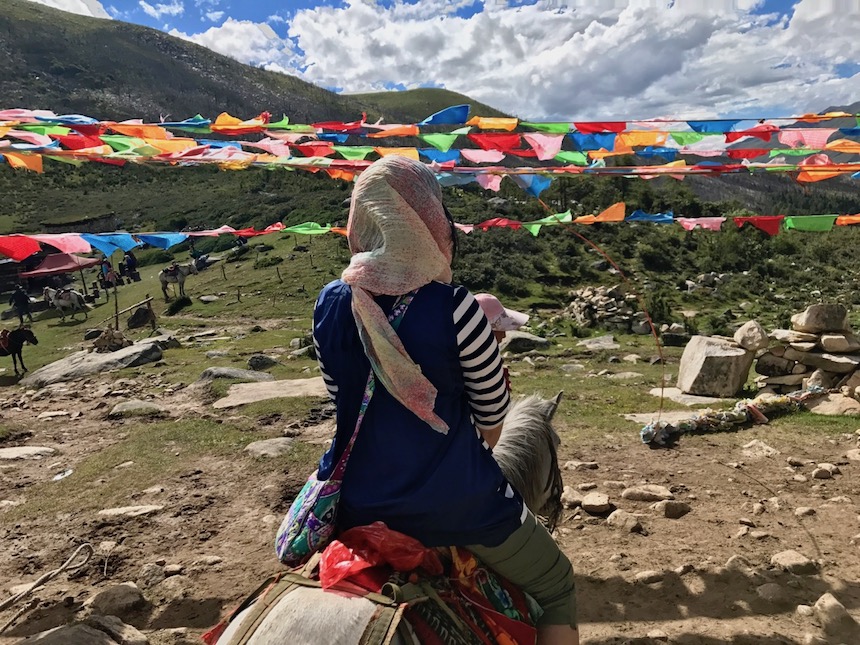
Yvonne on horseback amid the desolate beauty of China's mountainous frontier lands in March of 2018.
Yvonne’s great grandfather and ancestors operated the main horse station and guesthouse in Xichang for the Horse and Tea Road (chamagudao), the second great road of Asia after the more famous Silk Road. Yvonne still remembers how her grandmother, in the last stage of her life, still loved eating the special soy nuts that she had received as a child from the passing tradesmen. The Tea and Horse Road connected Southeast Asia, Southwest China, Tibet, Burma, and India through the most terrifying gorges, high-altitude mountain passes, and tiny rope bridges slung over the mightiest rivers on Earth from the Tang dynasty (8th Century AD) to the mid-20th century. The city of Xichang was one of the hub cities on that long, miraculous road. In fact, it is only recently that Yvonne and her husband Yves heard old family tales of caravans (mabang) arriving at the city gates with untold treasures after braving bandits, treacherous mountains, and sheer exhaustion on the toughest road in Asia. It is also at that point that Yves understood why his modern Vancouver wife could suddenly spring on top of a hardy Tibetan mountain pony and appear as natural and unfazed by altitude as the brave ponies themselves. She was a child of the frontier land, carrying in her the ancient tales and free spirit of the mountains.
Remarkably, Yves spent his own youth in France devouring stories about the Silk Road connecting Europe with ancient China. He read the tale of Tintin in Tibet over a hundred times, and once worked for the Michelin company in part because they had been the key sponsor of the daring Yellow Cruise in 1931-1932, the first automobile crossing of the entire Silk Road, from Paris to Peking. And Yves had long been closely involved with the Society of French Foreign Missions of Paris (MEP). These missionaries were most active in Sichuan and Yunan from the 1880s to 1949. They built a cathedral and school in Xichang, right next to Yvonne’s ancestral home, the same school that Yvonne's mother would attend more than half a century later.
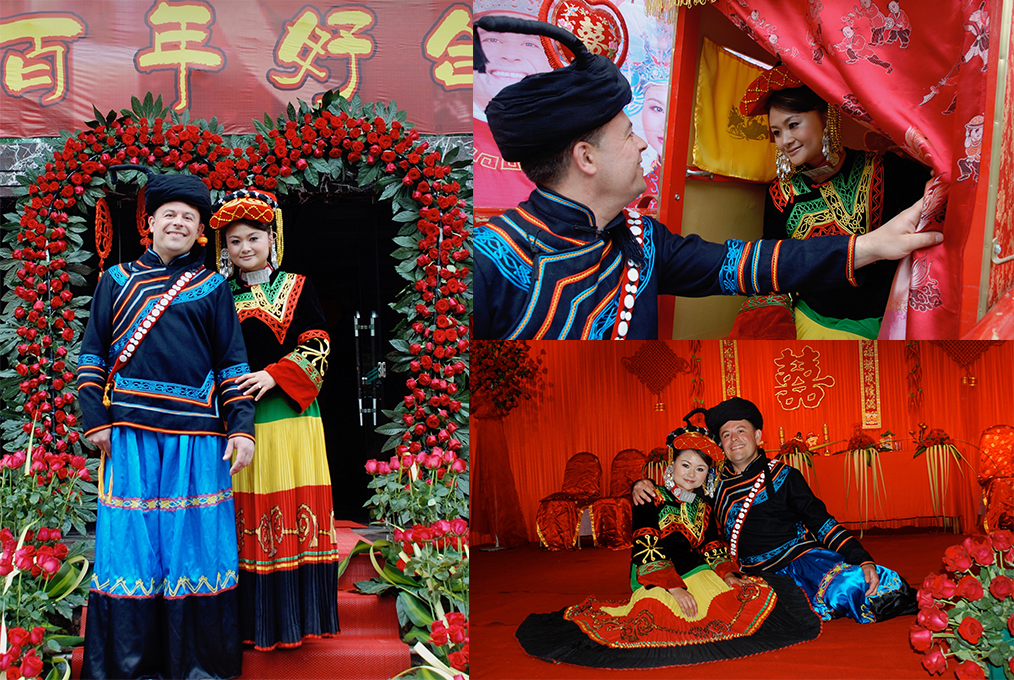
Yvonne and Yves return to Yvonne's ancestral home of Xichang in 2009 to celebrate their wedding in traditional Yi attire.
By the early 2000s, both Yvonne and Yves had built their lives in Vancouver, where they met. But Xichang welcomed them back for an unforgettable wedding ceremony set by the side of the Qionghai Lake and under the great mountains of Da Liang Shan. They followed both Yi and Han rituals as a nod to old friendships and out of mutual respect to two great peoples, despite their fractious history. The wedding event opened new avenues into a remote and mysterious land, echoing the human joys, pains, and creations from centuries and millennia gone by.
It was the continuing common quest for ancient roots and love for this rugged land that motivated Yvonne and Yves to return for a deeper visit, and to start writing about the people and tales of this mysterious and long-isolated rugged frontier land.
Until recently, this was a very isolated region of China. As late as 1959, Yvonne’s mom needed to travel for three days across mountains to Mianning County to catch a bus to Chengdu (which itself would take over 24 hours). By the early 1970s, the most dramatic train line in China was built (by the PLA) between Chengdu and Xichang, with hundreds of gravity-defying bridges and deep tunnels. It was such a heroic feat of engineering that China proudly offered a large ivory sculpture commemorating the opening of the line to the UN headquarters in New York in 1974. But it was such an unsafe line that it would still take 12 hours to travel from Chengdu to Xichang. Nowadays, Xichang is accessible by plane, but other cities in Da Liang Shan, and other cities visited for this piece, require long days of travel by bus on truly scary roads, where you often lose your last meal over mile-deep ravines. Travel to Da Liang Shan requires local knowledge, fluency in Yi language, local contacts, and is easier when working through the local governments.
While global analysts often focus on Beijing, Shanghai, Guangdong, and sometimes Hangzhou, as core locales to track China’s ongoing modernization and struggles, some of the fastest and most complex changes are currently taking place in China’s Southwest frontier lands. Provinces and municipalities such as Sichuan, Chongqing, Yunnan, Guizhou, Qinghai, Xinjiang, Gansu, and Tibet are not only all at the top of provincial growth tables and at the centre of the current Belt and Road Initiative (BRI), but they are also at the heart of China’s efforts at ecological, technological, and societal transformation. Many remote areas, long forgotten, poor, and unreachable, are now seeing high-speed train and high-speed highways interspersed among mountain tops dotted with modern wind turbines or solar panels. Tea houses, shops, and newly developed guest houses are quickly shifting to cashless payments through WeChat or Alipay, even in the most isolated counties of these frontier lands. And eco-tourism, along with a new type of real estate, has started to boom in these formerly backwater areas.
In other words, the remote frontier lands of China have become focal points for economic, technological, ecological, and societal leapfrogging. At the same time, such development is uneven and imbalanced, leading to social and cultural stress.
In fact, the economic, ecological, and cultural transformation of these remote areas is seen as such a priority that China’s top leaders regularly come for inspection visits, including President Xi Jinping. In his report to the 19th Party Congress delivered on October 18, 2017, Xi committed that “by the year 2020, all rural residents living below the current poverty line have been lifted out of poverty, and poverty is eliminated in all poor counties and regions. Poverty alleviation should reach those who truly need it and deliver genuine outcomes.” He has separately highlighted the poorest counties and is committed to visiting all of those to ensure real change on the ground. On February 11, 2018, Xi arrived in Zhaojue County for such an inspection, the very county that we visited with our team in mid-January and that we document in the first blog of this China’s Frontier Lands series. Xi also visited sites of scientific development and donned the traditional cloak of the Yi people.
In the late 19th century, Yunnan and Sichuan were the sites of competing expeditions to remote areas by scientists, explorers, and missionaries from France, the UK, but also Germany, the U.S. and even Canada. [2] The French built the narrow-gauge Kunming-Haiphong railroad (connecting China and Vietnam) in 1904-1910 and brought coffee plantations to Yunnan that remain to this day. During the warlord period after the 1911 Chinese Revolution, centralized control collapsed in the region and Sichuan was the site of great fragmentation and competition among warlord armies.[3] Yunnan was in a similar situation.

Prior to the arrival of modern infrastructure and political will, crude bridges like the one in this historic photograph were the primary means of traversing the rivers and canyons of China's rugged frontier lands.
The Long March of Mao’s Red Army in 1935 famously crossed Yunnan, as well as the Yi territory of Da Liang Shan (where they struck a famous agreement with Yi chiefs at Yihai Lake) before crossing the great Dadu River at Luding. During World War II, the mountains of Sichuan and Yunnan were the forbidding obstacles that courageous “Hump” pilots overflew as they brought supplies from British India to the embattled armies of Chiang Kai Shek in Chongqing and Chengdu, and where Flying Tigers battled Japanese fighters. Xichang and Kunming where the last holdovers of Chiang Kai Shek’s nationalists at the end of the Civil war in 1949 and 1950. Deng Xiaoping led the People's Liberation Army (PLA) conquest of the South West and spent time in Xichang and other parts of Sichuan from his headquarters in Chongqing (1950-1952). These lands echo the footsteps of history, and once again, find themselves at the heart of China’s transformation.
Our China’s Frontier Lands blog series reports on a few of these frontier areas in Sichuan and Yunnan through reports, photos, and analysis. It builds on a series of research trips in those areas from 2015 to 2018. Two research missions in June 2015 and January 2018 took place in partnership with a team led by Professor Xue Dayuan (project leader at the College of Life and Environmental Sciences at Minzu University of China in Beijing). These missions were part of the college’s broad-based investigation of the traditional knowledge associated with biodiversity in China’s minority areas, in support of China’s commitment under the Nagoya Protocol to the Convention on Biodiversity (CBD), and relied on the support of local university partners. Yvonne and I organized two other visits in remote areas of Sichuan on our own.
The series provides field observations, context, and photographic reports from four regions:
- The Da Liang Shan Region (including Zhaojue County, Butuo County, and Meigu County, in Sichuan): Land of the Yi people, visited in January 2018. Exploration in this region reveals an amazing richness in biodiversity and traditional Indigenous knowledge in the midst of hard work to eradicate poverty and bring renewable energy to the poorest counties of China.
- The Luguhu Lake Region (Sichuan and Yunnan, with contrast to Qionghai Lake in Xichang): land of the Mosuo and Yi, visited in August 2017 and January 2018. The region boasts some of the most pristine lake ecosystems and beautiful mountain parks in Sichuan, along with rich Indigenous knowledge and culture. These areas are at the forefront of an effort to combine eco-tourism, environmental protection, and some measure of wealth and recognition for local Indigenous people.
- Lijiang and the ancient Tea and Horse Road:visited in June 2015 and September 2017. Lijiang is on the UNESCO world heritage list and one of best preserved ancient cities in China. It is the hub of the ancient road linking Tibet with Southwest China and Southeast Asia, as well as a modern hub of ecological and cultural tourism in the region.
- Protected natural reserves and traditional knowledge research in Yunan (Yuanyang, Puer, Xishuangbana):visited in June 2015. In this region, various models of biodiversity protection are being tested along with new efforts to recognize traditional knowledge.
In addition to these four regions, the China’s Frontier Lands series explores three cross-cutting themes:
- Poverty alleviation (China’s 2020 plan), and what is happening on the ground in terms of economic, transport, and energy revolution, as well as enduring obstacles;
- Biodiversity protection and the shift toward green technology, including the implementation of protection targets under the Nagoya Protocol to the Convention on Biodiversity (CBD), the creation of national parks and wetland reserves, and the rise of eco-tourism;
- The recognition and inventory of traditional knowledge (also now protected under the CBD protocol) and the empowerment of a new class of cadres from minority backgrounds, in the larger context of the complex history between Indigenous people and Han people, as well as occasional foreign visitors.
For Canadians, there is much to learn from the dynamism, leapfrogging examples, and complexity of China’s great frontier lands. They are not just fascinating environmental and cultural locales for curious students or tourists, they are also a key prism for the understanding of the multi-faceted transformation of China and its connectivity with the rest of Asia.
All images in this series courtesy Yves Tiberghien.
[1]
a. On the French d’Ollone expedition of 1906-1907: D’Ollone, Henrie Marie Gustave. 1911. Les Derniers Barbares: Chine, Tibet, Mongolie. Paris: Pierre Laffite & Cie (a book which received an award from the Académie Française and was reprinted in 1917 by Forgotten Books (London).
b. On the French Legendre expedition of 1908: Legendre, A-F. 1910. Le Far-West chinois – Kientchang et Lolotie. Paris: Editions Plon.
c. On the German 1913 visit (Fritz and Hedwig Weiss): Wyss, Tamara. 2011. “Searching for the Lolos: Tracking Fritz and Hedwig Weiss’s trip to the Liangshan Region in 1913” pp. 91-115 in Denise Glover, Stevan Harrell, Charles McKhann, Margaret Byrne Swain Ed. Explorers and Scientists in China’s Borderlands, 1880-1950.
d. About the fatal visit by Englishman John Weston Brooke in 1908, who did not live to tell the story: see Wyss 2011 and Legendre 1910 cite above.
[2] See among others the excellent book edited by Denise Glover, Stevan Harrell, Charles McKhann, Margaret Byrne Swain. 2011. Explorers and Scientists in China’s Borderlands, 1880-1950.
[3] Source: Robert A. Kapp. 1973. Szechwan and the Chinese Republic: Provincial Militarism and Central Power, 1911-1938.
Chapter One: Deep into the Remote Cold Mountains of Da Liang Shan +
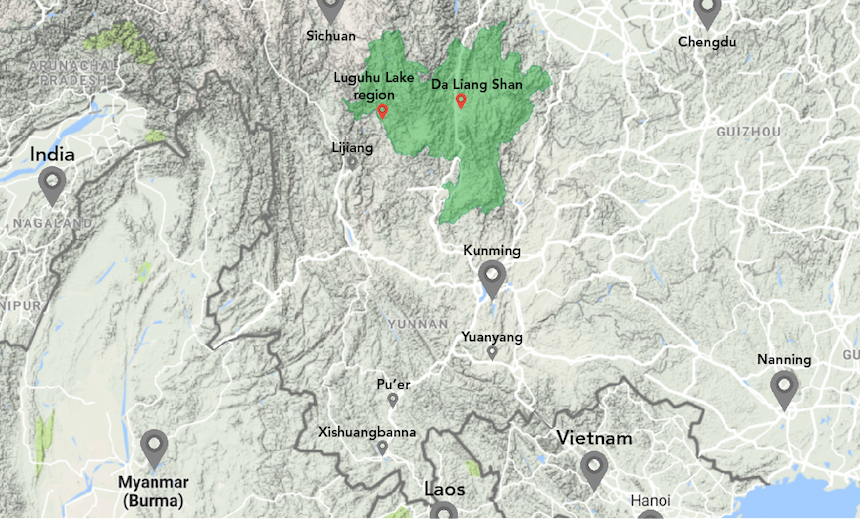
By Yves Tiberghien, Yvonne Xiao Tiberghien, and Dayuan Xue
On January 11, 2018, after days of preparation in the city of Xichang, in the south of China’s Sichuan Province, our team was getting ready for the big expedition into the ‘Big Cold Mountains’ (Da Liang Shan, 大凉山), the heart of Yi country, a long-forbidden and remote land. We would cross high mountain passes covered with ice and snow on dangerous roads and enter the three poorest counties in China. Although Yvonne grew up in the once fortified city of Xichang at the gates of this rugged land (formerly called Lolo land), she mostly heard frightening stories of the wars and conflicts between the Nuosu (now the Yi) people, and had never entered the region. After centuries of conflict between Yi and Han, there always remains a sense of unease in going up to the hidden Yi valleys.
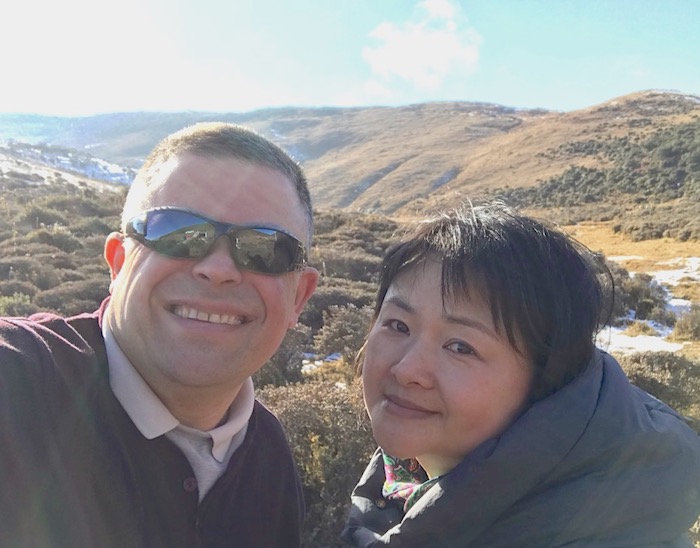
Selfie! Adventurers Yves and Yvonne on a mountain in Da Liang Shan, Sichuan, traditional home of the Yi people; elevation: 3,500 metres.
Yves had read the expedition report of French Commandant D’Ollone, who travelled the same route in 1906 under the restraining guidance of Père Monseigneur Jean-Budes de Guébriant, missionary of the Missions Étrangères de Paris based in Xichang (then called Ning-Yuan Fu).[1] For sure, this book was part of the colonial genre and is steeped in the sense of superiority exhibited by dare-devil European explorers who saw their exploits as pushing the limits of knowledge and national prestige.
Yet, behind this shocking attitude to modern readers, such books contain factual observations, and, in D’Ollone’s case, even a sense of friendship and eventual bonding with the Lolo people. Amidst harrowing stories and many near-death experiences, the book describes Liangshan as a forbidden land of warrior Lolo people, where any Han Chinese or foreigner would be killed or enslaved as soon as they trespassed the last border area above Xichang. D’Ollone also felt sympathy for the enslaved Chinese in the city of Zhaojue. To him, they appeared to feel some hope of freedom upon seeing foreigners passing through the region, alas an impossible dream.
That night, after Yvonne shared all of the stories she heard in her childhood and then mischievously wished him good night, Yves had bad dreams of a frozen land and a warrior people who would make him live out his life tending pigs in a tiny dark hut.
Enter the Yi
As noted by anthropologist Stevan Harrell, the Yi comprise a large combined ethnic group of about nine million people designated by the People’s Republic China in the early 1950s and encompassing formerly independent groups such as the Nuosu, the Sani, the Lipo and many others in Sichuan, Yunnan, Guizhou, and Guanxi (with another million spread out across Vietnam, Laos, Thailand, and Myanmar).[2] They have a sophisticated written language with 819 official characters that is neither derived from Chinese, nor from Phoenician scripts (such as Tibetan, Burmese, Thai, and Indian languages). The Yi language exhibits several distinct branches and has generated complex books over the centuries.[3] The Yi once had a great kingdom based in Dali (Nanzhao Kingdom) in the 7th to 9th centuries. They fascinated European explorers because many were very tall, with long noses and facial features that were decidedly Indo-Aryan. Modern Chinese geneticists have indeed found that the Yi gene pool seems to point toward a combination of Indo-Aryan, Mongol, and Chinese-Asiatic origins.
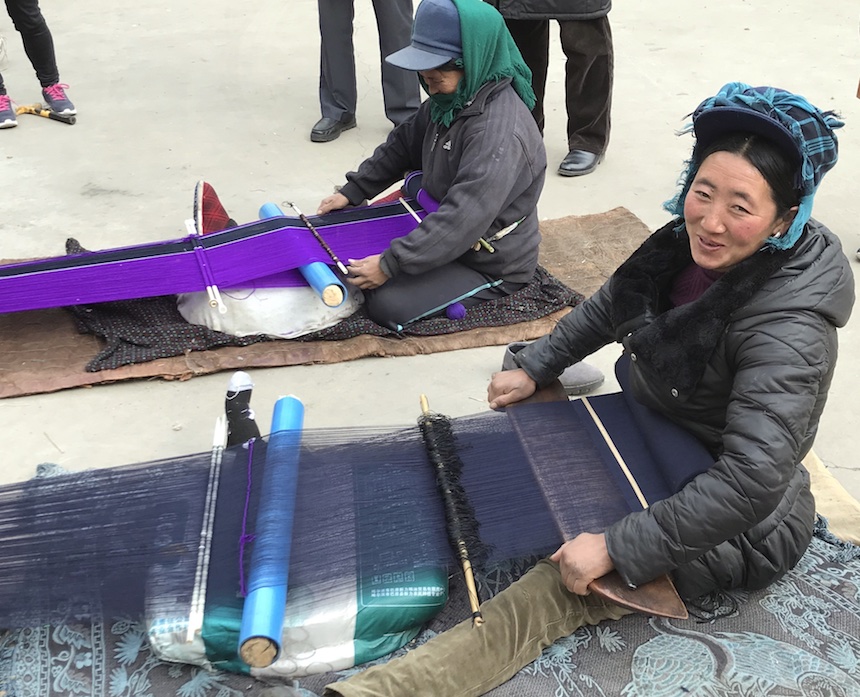
Yi women weaving traditional clothes in the city Butuo, in the heart of Da Liang Shan, Sichuan.
Over the centuries, the Yi developed a caste system reminiscent of Indian society, and some of the most complex embroidery and jewelry. Their oral history recounts long journeys in the past before they settled frontier lands in the Himalayan region of China and South East Asia. The mystery of the origin of the so-called “last barbarians” on Earth is actually what motivated de D’Ollone’s mission in 1906-1909, sending him as far as Mongolia and Tibet as he crossed the cradle of their civilization. Clearly, the Yi used to live in the valleys of Sichuan and Yunnan as well, before being displaced over centuries of war by migrating Han Chinese, and pushed into the mountains.
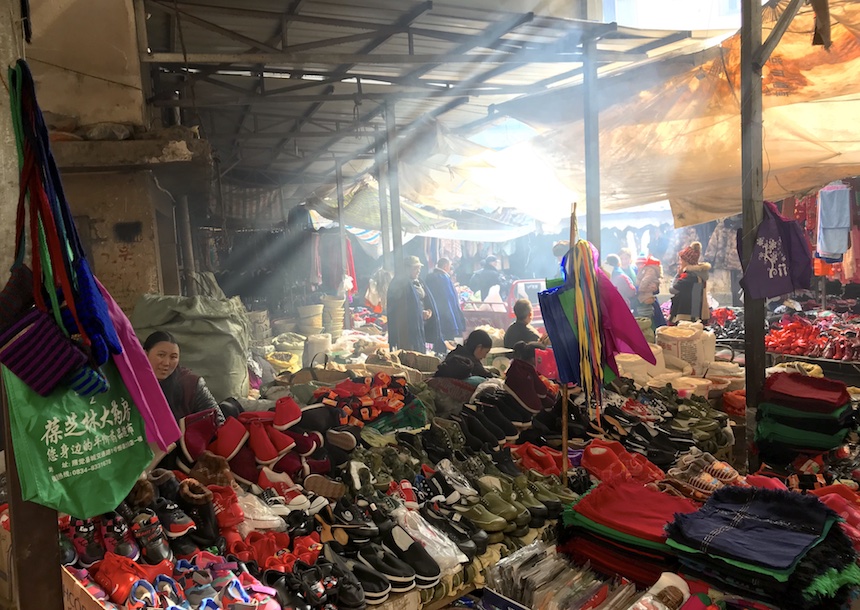
A traditional marketplace of the Yi people in the city of Zhaojue, Da Liang Shan.
Stevan Harrell writes: “The Nuosu resisted rule by the Chinese, Mongols, and Manchus for thousands of years. As late as the 1940s their homeland was known as Independent Lololand. They captured Chinese intruders and sold them into slavery, and are still proud of their reputation as brave warriors. The Nuosu have retained their original religious traditions and practices to the present day, little influenced by Buddhism, other Chinese folk religions, or Christian missionaries.” [4]
The expedition departs
On the morning of January 12, our little expedition left Xichang and Qionghai Lake (altitude 1,500m) and starting a seemingly endless drive up the steep mountain road. We were led by Professor Xue Dayuan (薛达元), Professor at Minzu University in Beijing, Director of the Biodiversity Lab, and former Chief Biodiversity Scientist at China’s Ministry of Environment. With us was Professor Aluo Jimu (阿洛吉木) from Xichang University (西昌学院), a scholar on Yi (Nuosu) society and culture and a Yi native herself; Piao Jinli, a post-graduate researcher at Minzu University of China (and an ethnic Korean); Lan Wen Juan, an undergraduate student from Minzu University of China (and ethnic Se 畲); as well as our driver Sha, upon whom our lives depended on the icy mountain road. Driver Sha was also a member of Yi community from another remote county, which is now known by tourists because of its famous Lugu Lake.
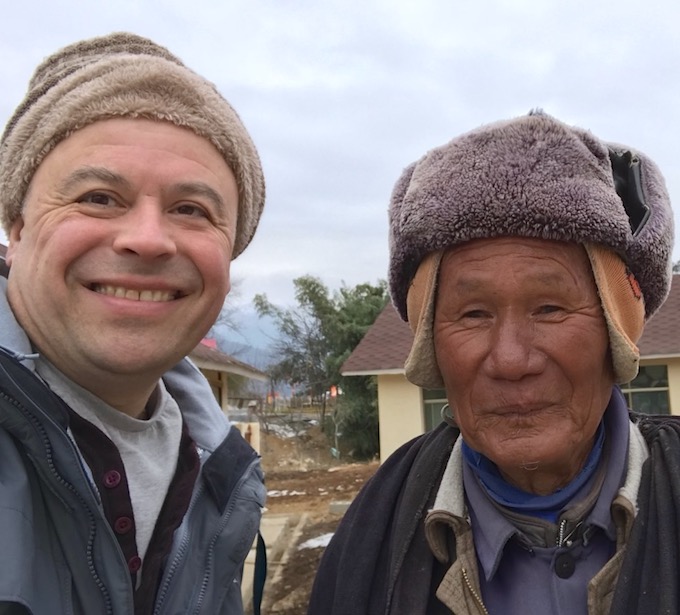
Yves meets with a Yi village chief in the model village of Yi Hai (Mianning County), where the Red Army made an alliance with the Yi people in 1935, gaining safe passage for the Long March.
We were a very diverse bunch, bringing together our different life stories and different expectations in this research trip, leading to fascinating interactions. Local conversations with villagers, local cadres, or city people were held in the Yi language with translation into Sichuanese, which in turn Yvonne would help translate to Mandarin and English.
Quickly, as warned, after riding through hundreds of sharp curves on a road apparently just renovated, we reached 3,200 m of altitude and complete ice and snow, with crashed cars on the curbs. Entering the cold mountains of the Yi is not for the faint-hearted! From then on, we descended into the suspended plateau and hidden valleys of Butuo, Meigu, and Zhaojue counties in the very heart of Da Liang Shan. This Himalayan fortress of ancient times remained quite high in elevation (2,000m to 2,400m).
A motivated adventure
What motivated this research expedition into still extremely remote lands where few outsiders venture was not the ancient urge to “discover” the already existing others, nor the greed that led former Chinese merchants to plant opium in the 1920s and 1930s in areas that lay behind Chinese rule. And it was not the revolutionary spirit of 1951-1957 that gradually led to the abolition of slavery and castes and violent land reforms and the subsequent cultural revolution. This time, the trigger was a UN treaty on biodiversity, namely the Nagoya Protocol on Access to Genetic Resources and the Fair and Equitable Sharing of Benefits Arising from their Utilization to the Convention on Biological Diversity, ratified by China in 2016 (but not by Canada).[5]
This new protocol offers ownership for genetic resources such as plants and seeds – but also animal husbandry and even traditional knowledge and technology (such as medicinal practices and weaving) – to Indigenous people, and requires any user of such knowledge to enter into benefit-sharing agreements with original owners. It is meant to finally put an end to the colonial and post-colonial practices of seed stealing or gene hunting.[6] For Yi and Chinese scientists, what remains to be done is to document and protect the resources and know-how developed by peoples such as the Yi over millennia. Our mission was to pursue an “investigation on the traditional knowledge associated with biodiversity in Yi People area” and was supported by the 111 Project of Minzu University of China on ethno-biodiversity.
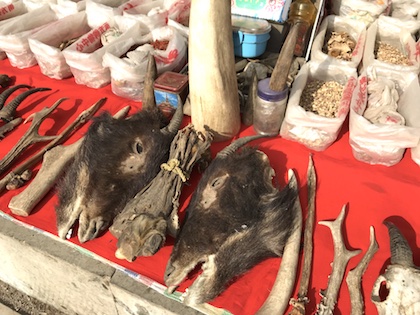
A traditional-medicine 'pharmacy' of the Yi people in Zhaojue, Da Liang Shan.
Supported by Minzu University, Xichang University, and Aluo Jimu’s vast human networks in the region, and by the Da Liang Shan prefectural government, we were able to spend several days of deep interactions with a full range of people in the three counties. This included frank discussions with party cadres and village or city leaders, as well as spot visits to remote villages, market places, local cultural museums, a school, or random families or farmers. We started with the rural city of Butuo, before passing by the formerly prosperous village of Zhuhe and “the city of beautiful girls” (Meigu, 美姑), before finishing with a long visit to the core city in the region, Zhaojue. Interestingly, Zhaojue used to have Chinese inhabitants and, in order to be officially incorporated as a city by Ming China, had its required wall built in the 16th century, before the Yi mostly pushed out the Chinese in the 19th century. It later was the capital of Da Liang Shan, before Xichang gained that privilege.
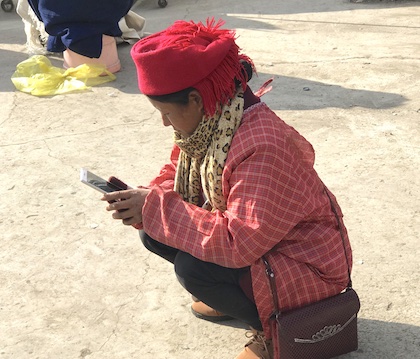
A traditional Yi woman on her mobile phone outside a marketplace in Zhaojue, Da Liang Shan.
Everywhere, we were impressed by the combination of great natural beauty and extreme poverty, deep pride of local people in Yi cultural heritage, and hopes of young people for modernity. We received great hospitality and were moved by the warm conversations and exchanges in the midst of very cold weather and frigid winds. We saw talented silver smiths and traditional weavers (mostly women) producing absolute wonders worthy of UNESCO protection in the most desolate and crudest conditions, right on the cold and dirty floor.
What did we find in this remote exploration?
First, our team identified great genetic diversity in agriculture developed over centuries by the Yi people, especially locally adapted varieties of buckwheat, black goats, black pigs, and mountain sheep. Various fruits such as walnuts have also been selected over centuries. Handicraft, traditional weaving, silverware, and medical traditional knowledge were all identified as a unique reservoir of human diversity and cultural treasure. Much could be done to protect these activities and find partners who could help the Yi people turn this heritage into resources for their livelihood.
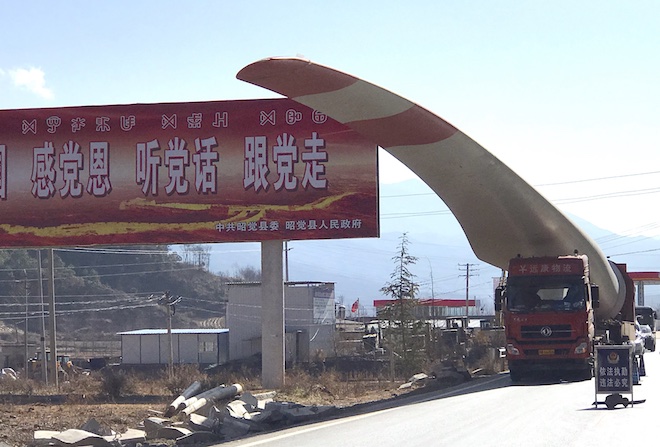
A truck carries a wind-turbine blade headed for the mountaintops of Da Liang Shan.
Second, we were surprised by the extent at which green technologies are spreading in these remote regions. Every day and on every road, we suddenly faced massive trucks carrying gigantic blades for wind turbines being installed on every mountain top with the support of local people, who see a source of clean energy. Solar panels also proliferate. These new technologies, along with roads and the high-speed train being built down in the valley of Xichang below, could well enable the region to leapfrog to new possibilities before polluting industries or coal-burning plants are ever built. The region is poor and deforested, but remains otherwise pristine. There is great potential for eco-tourism, if done in the right way.
Third, the dominant themes of conversation always converged toward poverty alleviation. Clearly, the start of the Deng Xiaoping era of reforms and modernization has left Da Liang Shan behind and has created huge distortions. Young men started immigrating to Yunnan, Sichuan, and as far as Guangdong Province, where they were exploited and where they turned to drugs, some bringing back AIDS to their homeland. The region became one of the most afflicted areas with AIDS in China in the 1990s, as drugs became associated with wealth and status. It has taken relentless education and medical campaigns by both government, domestic volunteers, and overseas NGOs to stem the wave of AIDS (although it still has a long way to go).[7] Even the United Nations was once involved, although outreach workers found it hard to work with the Yi clan system.
Xi Jinping’s government has identified the three counties of Da Liang Shan as the poorest in China, and they are specifically targeted by the 2020 plan to eradicate poverty across China. Everywhere, we met overworked party leaders and village cadres who could not afford to take any weekend off, and who roamed the land to introduce new crops, generate new small-scale manufacturing and tourism, or to create new job opportunities and raise education. We encountered school girls who dream of a better life and to help their families out of poverty. We were impressed that nearly all village and party leaders were Yi people who had risen through education or military service to positions of leadership.
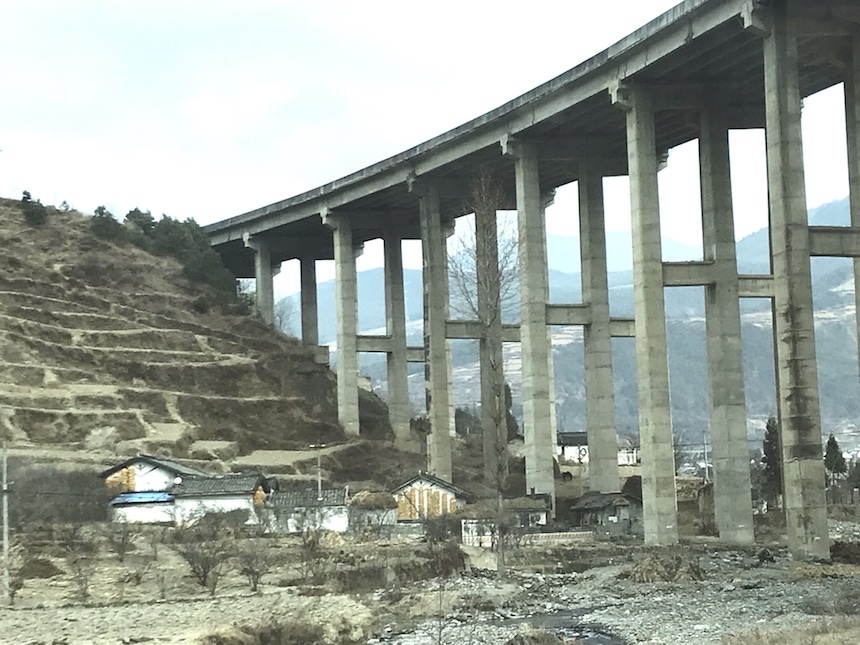
A modern bridge along the new super-highway built at 2,000 metres between Chengdu and Xichang in Sichuan, and Kunming in Yunnan.
Yet, these efforts face forbidding obstacles that go beyond the sheer isolation and lack of connectivity to big economic centres. One village cadre explained that divisions among clans in Yi society often hampers development strategies, in addition to the fight against AIDS and the challenges of the rugged land. Development may also be hampered by a lack of trust between Yi and Han Chinese after centuries of conflictual relationships, despite the fact that more and more Yi and Han are connected by the convenience of modern transportation and Internet fever.
Finally, we were struck by the painful and complex challenges facing a proud society with an ancient culture developed for centuries in quasi-isolation as it is thrust into modernity. Young people learn about the bigger world and stop listening to elders. Temptations tear families and clans part, while clans themselves continue to fragment the larger society with their legacy disputes and persistent in-fighting. How can the Yi people find a path that allows them to continue nurturing the unique knowledge, culture, native customary laws, and environment that they crafted over thousands of years while moving out of poverty? Can the Han Chinese support such a process in a mutually respectful way?
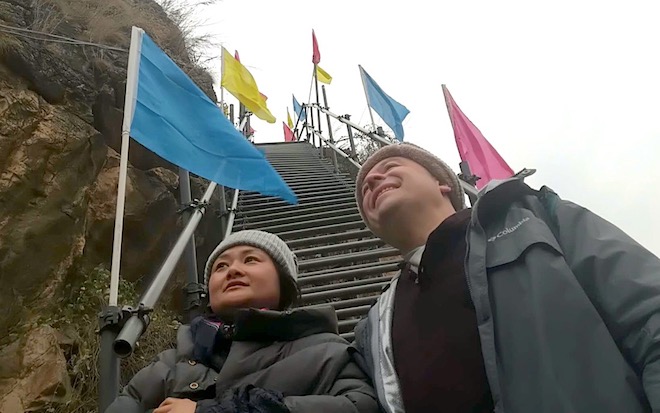
At the foot of the rugged "cliff village" of Xuan Ya Cuan in Da Liang Shan on opening day of the metal steps replacing a 1,000-metre vine-ladder that local children previously climbed to and from school.
One moment remains deeply impressed in our minds. On January 13, 2018 we drove through two hours of deep and terrifying gorges to arrive at the foot of the most astonishing and recently famous village in the region: Atuleer Village (Xuan Ya Cuan, 悬崖村in Chinese). This is a village sitting on top of a nearly 1,000-metre vertical cliff on all sides, from which children have been descending and climbing every day for school on simple vines. Chinese TV discovered the village two years ago and the pictures even attracted President Xi Jinping’s personal attention. Sichuan Province made a deal with a large company that rapidly built a metal ladder. January 13 was the day the new ladder opened up in great fanfare with Sichuan Province leaders lining up alongside traditional Yi chiefs and school children in the most moving scene we saw. The heartfelt songs of the children rose to the sky and echoed across the mountains, in a great expression of hope for a better future.[8]
ENDNOTES
[1] D’Ollone, Henrie Marie Gustave. 1911. Les Derniers Barbares: Chine, Tibet, Mongolie. Paris: Pierre Laffite & Cie (a book which received an award from the Académie Française and was reprinted in 1917 by Forgotten Books (London).
[2] Harrell, Stevan. May 2018. “Nine Million People You Might Never Have Heard Of,” Los Angeles Review of Books, China Channel.
[3] For a wonderful analysis, see Stevan Harrell’s post on China Channel.
[4] Harrell, Stevan. May 2018. “Nine Million People You Might Never Have Heard Of,” Los Angeles Review of Books, China Channel.
[6] See Juma, Calestous. 2014. Gene Hunters: Biotechnology and the Scramble for Seeds. Princeton: Princeton University Press. For a particularly vivid story of how the British East India Company, the Venerable Company, stole tea plants and know-how from China and brought them to British India in the 1848-1851 in a well-designed clandestine operation, see Rose, Sarah. 2010. For All the Tea in China: How England Stole the World’s Favorite Drink and Changed History. New York City: Penguin.
[7] For a well-known narrative on this AIDS crisis, please see Liu, Shao-hua. 2010. Passage to Manhood: Youth Migration, Heroin, and AIDS in Southwest China. Stanford: Stanford University Press. Studies of the Weatherhead East Asian Institute, Columbia University.
Chapter Two: Lugu Lake and the Kingdom of Daughters +
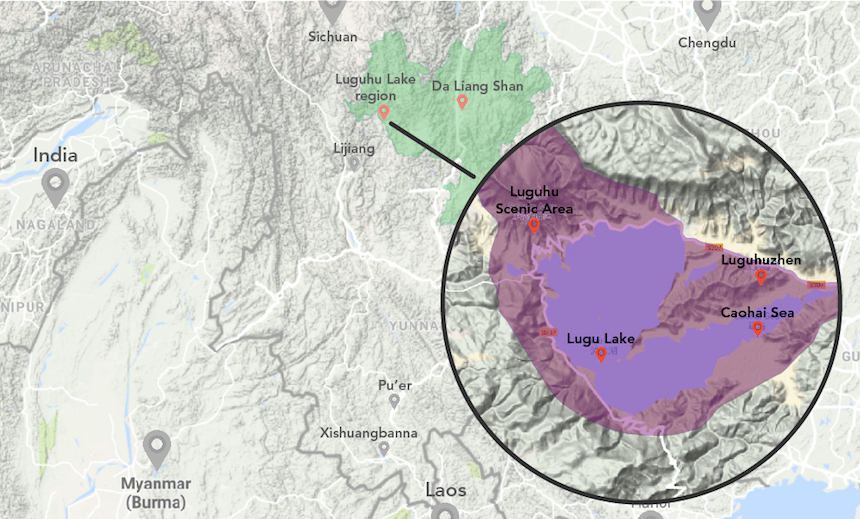
By Yves Tiberghien and Yvonne Xiao Tiberghien
Mythical Lugu Lake (泸沽湖, Lugu Hu) . . . imagine a remote and fathomless pristine blue lake at 2,700 meters above sea level and surrounded on all sides by tall mountains and deep, impenetrable gorges. Imagine also a people, the Mosuo (a sub-group of the Naxi people), who migrated from the north in Qinghai and Xingjiang through Gansu and down steep gorges to Sichuan over 1,500 years ago, eventually settling around this isolated high-altitude lake and nearby river valleys. Over centuries, the Mosuo developed the rich and unique Dongba culture, including elements of Tibetan Buddhism and a deep and respectful relationship with the ecological environment. They also developed one of the few remaining matrilineal societies remaining on earth, where children take on their mother’s surname and where the family structure is centred around mothers. “A Mosuo woman may have lovers during her lifetime and she may have many children. Yet each of them will perhaps have a different father, and none of the fathers will live with his children.”[1]
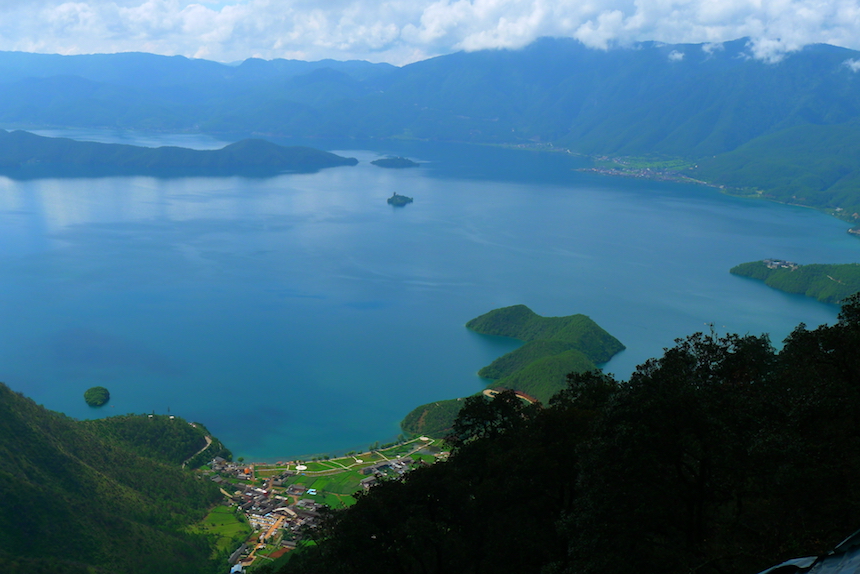
The Yunnan-province side of Lugu Lake, at nearly three kilometres elevation, as seen from an even higher mountain peak.
This beautiful and dramatic land is now being drawn out of remoteness and into modernity, with an airport completed in 2015 and an expressway under construction to link it with Chengdu. As the Lugu Lake region faces increasing numbers of tourists from large Chinese cities in search of a last bit of innocence, carefree atmosphere, and pristine nature, can the 40,000 remaining Mosuo people and their Tibetan, Yi, and Norzu neighbours find a new balance that preserves their rich cultural heritage?
To 1,700 metres, and back down again
For Yvonne, our vigorous Yi guide and driver, three relatives, and Yves, the journey to Lugu Lake started at dawn in the city of Xichang, Sichuan in early August 2017. We first crossed the valley around Xichang, with rich agriculture and lush fruit growing left and right. After some 40 km, we reached the giant Pangang titanium and vanadium mine complex with its ballooning clouds of smoke, as well as convoys of giant propellers for wind turbines getting installed on mountain tops. After that, we started a harrowing seven-hour drive through jaw-dropping cliffs, gorges and summits, gaining 1,700 metres of elevation, before dropping it all, and starting all over again. Recent rains produced great landsides and rockslides that had destroyed the road in countless places, often hitting cars. Vehicles dot the rivers or ditches below, in large part because of the new ‘alpha-male’ driving culture that has invaded these formerly remote mountains. Thousands of modern SUVs from Chengdu and other regional cities rush through these newly accessible areas, zooming past simple, placid hamlets that hang over the gorges. New and old China do meet on those roads, as the well-dressed Chengdu or Panzihua women come out of these cars to buy humble roasted potatoes, corn on the cob, and fresh fruit from the local Yi people.
Our Yi driver, Zhao Lei, was fearless and unstoppable, passing hundreds of beaten drivers, while blasting the latest Yi music hits and literally car-dancing through the gorges. Needless to say, I faced many times 1,000-meter deep ravines from close proximity and thought that the end was in sight. We later passed the great agricultural centre of Yanyuan, a booming county capital and a famous producer of beautiful apples and the best Sichuan peppers (花椒). There, we observed a huge expansion of roads, booming real-estate construction, and giant solar farms on the surrounding hills.
By the end of the day, after we climbed up along a river covered with electric dams every 30-50 km, the road suddenly opened up to a broad valley and the beautiful Lugu Lake. To face this gorgeous body of tranquil blue water after a long battle with looming rocks and daunting cliffs is a truly moving experience.
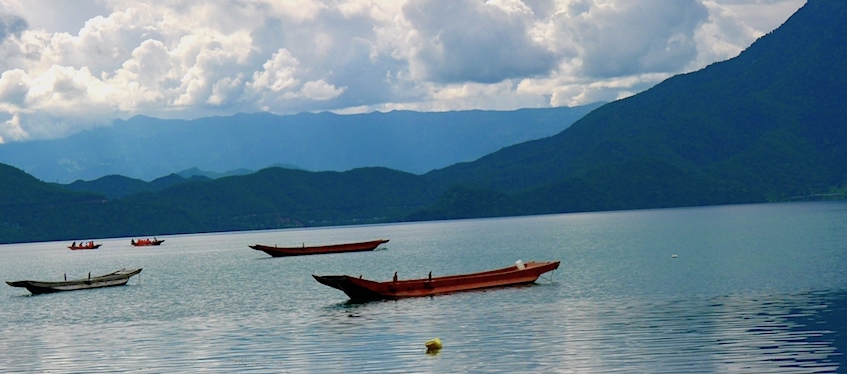
The traditional zhucaochuan longboats that pepper the waters of Lugu Lake.
The next few days offered us a chance to discover the extraordinary natural beauty of the lake and its surroundings, as well as the rich culture of the Mosuo people and others who live on the lake’s shores. One of the first sights on this lake is the the long, graceful wooden canoes developed by the Mosuo over centuries, the zhucaochuan (“pig-trough boats”) that glide on the big lake with the help of long wooden sticks and seem to merge into the landscape.
The Mosuo people: ancient matrilineal culture meets modern tourism
In today’s China, the Mosuo people have become well-known as one of the few ethnic communities in which women play the dominant role in marriage, family lineage, and inheritance. Today, literally hundreds of thousands of urban Chinese trek to these shores in hopes of finding those beautiful women who invite the men of their choice to their secret chambers at night. Chinese wives therefore forbid men to go alone to Lugu Lake and, of course, Chinese men dream of escaping to the shores of this ancient garden of Eden that offers a respite from rigid Confucian rules. Yet, do these millions of tourists realize that the 40,000 remaining Mosuo people are no match for this massive influx?
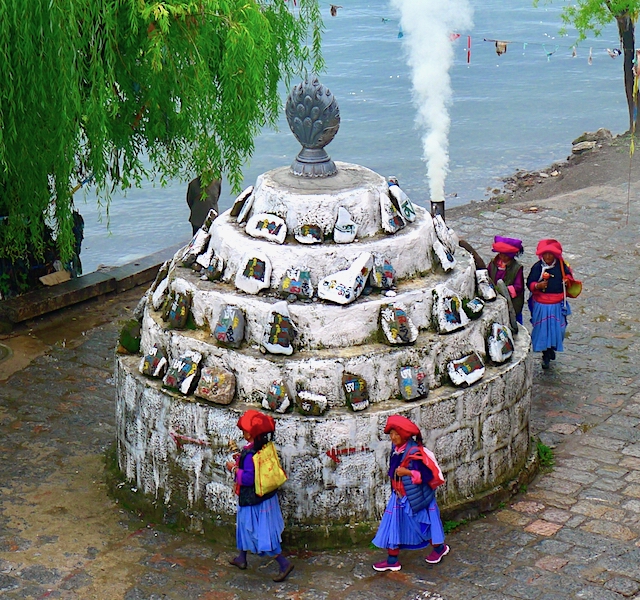
Mosuo women perform morning prayer around a small Tibetan Buddhist cairn on the shore of Lugu Lake.
Stepping back from this modern conundrum, Mosuo culture and society are indeed remarkable in many regards. In contrast to traditional Chinese family norms, Mosuo people favour daughters over sons. This is why the Lugu Lake area is known as the “Country of Daughters.”[2] One of the best modern depictions of Mosuo society as seen from the eyes of a woman is Yang Erche Namu’s Leaving Mother Lake (2003). Yang Erche Namu is a Mosuo native who grew up around Lugu Lake until age 13, travelled to Shanghai to study music, and became a writer. She moved to America and became quite a celebrity as a designer, model, and something of a sex symbol. In 2007, she even proposed to Nicolas Sarkozy.[3]
Mosuo society was almost unknown to the outside world until the late 1980s. One of Yvonne’s grand-uncles was the county chief of Zuosuo (another name for Lugu county) in the early 1960s after attending medical college. As a result, Yvonne’s family was somewhat well-informed about this unique culture. Of course, at that time, Chinese kids were not allowed to talk about the Mosuo “walking marriage.” Not surprisingly, Yvonne felt very natural when she started to talk to our boatman, a stocky young Mosuo with visual Mongolian facial features. Soon, the conversation became frank and colourful. The young man told Yvonne that he had a lover from Chongqing, a city thousands of kilometres away. The metropolitan woman took him back home after they fell in love at Lugu Lake and kept him for a month. He would stay home all day eating hotpot and waiting for her to come back from work; then, they would have fun together. Yvonne asked him if he believed in her love. He answered yes, of course. Yvonne later said she saw the stars of a dreamer in his eyes at that “of course.”
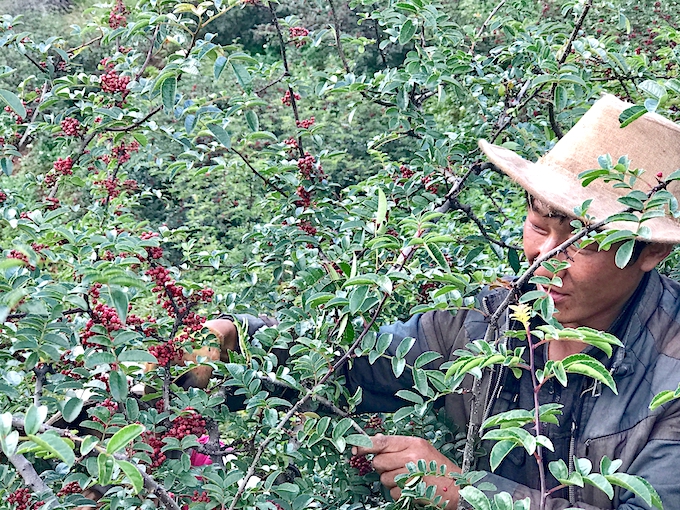
A young Mosuo man picks the famous Sichuan peppers, or 'hua jiao', in the fields above the local city of Yan Yuan.
This young Mosuo man would likely live all his life with his mother, grandmother, and their children, as an uncle and, later, grand-uncle. Different from other matriarchal cultures, Mosuo men actually are well respected in their family despite the fact that the older woman (A Mi) is the absolute head. A Mi holds the key to the family storage, and that key is the symbol of power. The woman to whom A Mi passes the key will be the future household leader.
Glimpses of Kublai Khan in the Modern Age
Amazingly, the Mongol armies of Kublai Khan crossed thousands of kilometers of the most rugged land on earth and invaded Sichuan and Yunnan from the north in their great offensive against the Dali Kingdom in the fall of 1253. Kublai Khan divided his forces into three armies.[4] Two columns went through Chengdu and the grasslands in the south, but a third column led by Uriyang-kadai took the very difficult northern path through the mountains and across valleys. It appears that this column invaded the Mosuo lands in 1253-1254, as part of the daring Mongol plan to attack the Song Empire from the rugged west, rather than from the well-defended northern frontier.[5] It is said that Kublai Khan introduced Buddhism to the region. The Mongol armies did establish outposts on the shores of Lugu Lake and left some Mongol soldiers to settle and administer this land, even though the real target was the Dali Kingdom and Yunnan. We were surprised to face this ancient history so directly, as our vigorous Mosuo boat pilot proudly explained that he was a descendant of the great Mongols and that this explained the strength and vigour of Mosuo men. And no doubt their attractiveness to the far-away women of metropolitan China.
Joseph Rock’s Fractious Legacy
It is impossible to go to Lugu Lake without hearing about the legacy of Joseph Rock. Not only was he the first Westerner to make it to Lugu Lake, he also visited the lake and lived on its shores and islands over the course of three decades between 1922 and 1949, when he finally left with great sorrow. An Austrian-born American, Rock came to Yunnan and Sichuan as a botanist, but became more of an explorer and anthropologist over the years. He worked for the US Department of Agriculture, produced ten stories for the National Geographic, and later was employed by Harvard’s Institute of Botany. He meticulously recorded what he saw in thousands of photographs and copious notes, but also brought thousands of native plants and cultural artifacts to the U.S. and beyond. He became extremely fond of Naxi culture and of the Mosuo people (a sub-group of the larger Naxi people), and lived with them, although he always kept his own space and distance.
There is definitely a tension in how modern China relates to Joseph Rock. The modern and well-endowed museum dedicated to the Mosuo people on the Sichuan side of Lugu Lake is a great place to feel that tension. On the one hand, the museum notes that Rock was the first Westerner to visit and document this region, thus inspiring the vision of a Shangri-La-like paradise in Western minds that partly informed James Hilton’s novel Lost Horizon. It is noted that Rock lived 27 years around Lugu Lake and put together the most comprehensive encyclopedia of Naxi language and culture at that time. “It was because of Rock’s outstanding contribution to Dongba culture and research and his enormous influences that he was considered the ‘Father of Naxi Studies’ in Western academia,” says one of the panels in the entire room dedicated to him, the ‘Joseph Rock Hall.’ The modern museum also shares in Rock’s sadness when he had to leave Lugu Lake in 1949, not saying however that he was expelled by the newly-founded People’s Republic in China. They reprint the words he left on that day on the walls of the pavilion that bears his name: “If this was my last visit to Lugu Lake, I would be very devastated, however, given my advanced age, what else could be said? I could only say goodbye to Lugu Lake with regret.”
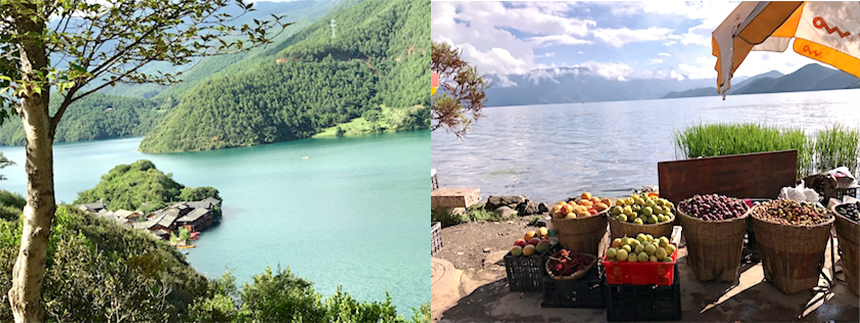
Views from the shore include local summer fruits ready for sale (right), and the small island of Wangfei Dao (left).
Yet, the museum also notes that Rock collected 80,000 samples, artifacts, and documents from the region and sold them for a hefty price to places such as Harvard University (Department of Botany) and even to the Pontifical Oriental Institute in Rome. They also note that he initially worked for the US Department of Agriculture.
Joseph Rock has been described as a “conglomerate of taxonomic and observational talents, as well as distinctive personality traits.”[6] As anthropologist Stevan Harrell writes, Rock was the quintessential Western explorer of Western colonial times, believing in “objective and classificatory science,” relying on photography as “objective knowledge,” and greatly benefitting from the position of “white privilege.” Offering “Naxi eyes on Joseph Rock,” He Jiangyu described how he hired and organized his teams of Naxi assistants in a quite mercurial way, maintaing some “sense of superiority as a white man” (128) and sometimes getting into real fights. He nearly killed one assistant, named Li Shichen, although they later became friends.[7]
Half-way between Lijiang and the Buddhist kingdom of Muli, Lugu Lake became a good local base for Rock’s explorations. He often stayed on Niluopu Island, hosted by a local official and one of his closest friends in China. In fact, it seems that Rock stayed hidden on this island for quite some time after August 1929 when pursued by people in Kangding, who blamed his rock-collecting for crop failures and wanted him dead.[8]
Yet, despite these colonial marks on his legacy, Rock has made a real comeback in modern China: “Even Rock, who was viewed equivocally by many Naxi, has once again become a local hero. At the same time, Rock’s own story has become one of the tourist attractions offered to visitors to Lijiang and nearby areas.”[9]
We heard similar ambivalence when discussing Joseph Rock’s influence with local Mosuo people. On the one hand, his black-and-white photos of the region are the only surviving photos from the 1920s or earlier, and are prominently displayed in local hotels or restaurants. One Mosuo man explained to us that Rock did help open up the region and bring economic development to the people here, who lived in isolation and poverty prior to his arrival. On the other hand, he criticized Rock for taking so many treasures away to North America and Europe, and even for “being a spy” on behalf of the United States.
Modern Policy Questions at Lugu Lake
Lugu Lake is a remarkable natural reserve. Due to lack of industry or prior pollution and high regular inflow of clean water, it boasts ‘grade 1 national surface water,’ the top level in China. It can literally be drunk as pure water. However, maintaining this pristine quality along with the natural beauty around it in the age of growing mass tourism is a real challenge. Jurisdiction over Lugu Lake is divided between Sichuan (2/3 of its coast) and Yunnan provinces (1/3 of its coast). The two provinces have different regulations. For example, Sichuan forbids the use of any boat engine, while Yunnan allows small electric engines on the same wooden boats. The Sichuan side is less developed and less touristic, while the Yunnan side has a more developed hotel infrastructure and, of course, the new airport (which opened in 2015). Currently, the area of Lugu Lake is protected as the “Mosuo Homeland Lugu Lake Scenic Area,” with significant entry fees (RMB 100 per person), but not as a National Park or future pilot national park. Commercial interests are significant and growing, many by local Mosuo people, but also by Han investors. What should be the ideal model of preservation and development for a rare place like Lugu Lake? What is the right balance between environmental protection, economic empowerment for local people, and Indigenous culture centrality? Our first round of observations saw both positives (growth of solar panels in particular, appreciation of the clean lake) and negatives (traffic jams of SUVs and large buses beyond the capacity of the small mountain roads).
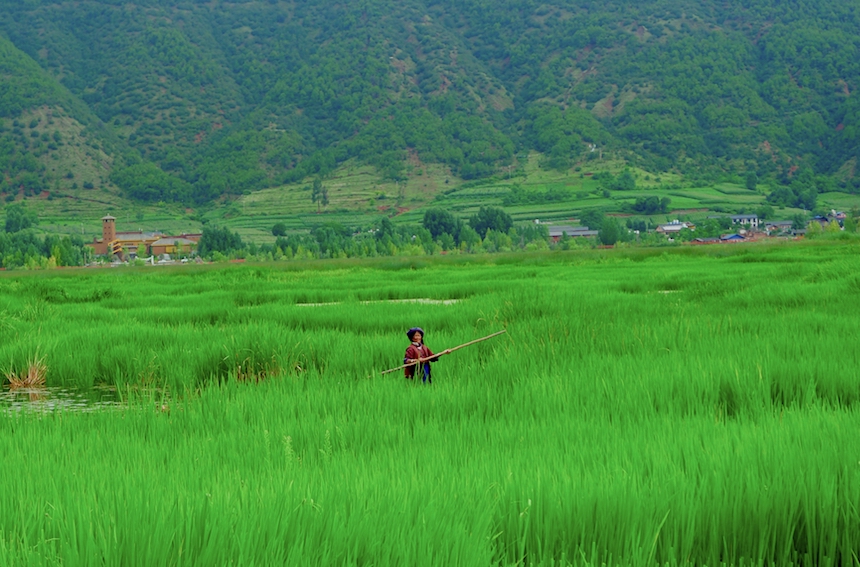
A traditional Mosuo woman navigates a sea of grass on the Sichuan side of Lugu Lake.
A second key theme present in Lugu Lake is the right relation to local Mosuo/Naxi culture in the context of fast-growing tourism. Official signage in the park certainly educates tourists on Mosuo/Dongba culture and its particularly harmonious relationship to nature. On the Yunnan side, we found large-sized stone explanations extolling “Mosuo people’s cognition on natural environment: integration of human and nature,” or “the ecological concept of Mosuo matriarchal culture: protect resources, control waste.” Tourism has clearly provided jobs and resources for local people, an eager market for their handicraft, and great demand for locally-run bed-and-breakfast hotels. At the same time, the sheer interest in Lugu Lake and growth in the numbers of tourists risk simply overwhelming the small size of the Mosuo economy and attracting large out-of-province investors into bigger hotels and tours. Can the right balance be found? Can local people empowerment remain a core part of the development model of Lugu Lake?
Finally, Lugu Lake is really at the frontier of the rise of eco-tourism and cultural tourism in China, balancing poverty alleviation with a respectful approach. By and large, we witnessed both an abundance of educational attempts by outside tourists and real trickle-down opportunities. But we also noticed that the trickle-down benefits of the Lugu Lake attraction remain quite localized around the lake and did not yet spread to the nearby mountain areas in Sichuan. We also noticed that the balance was fragile and that the current model would surely require some strong limitations on real-estate development and curbs on the flow of mass tourism. This will surely generate tensions. But Lugu Lake is a fascinating test case for a new kind of eco-cultural tourism, one that allows people to rediscover traditional inspiration and natural beauty.
As noted by the American geographer, ecologist, and anthropologist Jared Diamond, there is much to be learned from traditional societies about “life-long social bonds” and a sense of time and human quality. At Lugu Lake we find a similar chance to learn from the remarkable achievements of the Mosuo people in a remote environment and to open up the socially-constructed “walls” of “our own ignorance.”[10]
[1] Yang, Erche Namu & Mathieu, Christine. 2003. Leaving Mother Lake. New York: Back Bay Books/Little Brown and Company. P. 7.
[2] Yang, Erche Namu & Mathieu, Christine. Ibid. p.6.
[3] Lau, Joyce Hor-Chung (2007-12-29), "A Joker Woos a President, and Keyboards Clatter," The New York Times,
[4] Man, John. 2006. Kublai Khan: the Mongol King Who Remade China. London: Bentam Books. P.100.
[5] Rock, Joseph. 2007. China on the Wild Side: Explorations in the China-Tibet Borderlands: Yunnan and Sichuan. Vol. 1. P.11. Reprinted for original National Geographic articles published by Joseph Rock in 1926. For the story of the invasion of Sichuan and of the Dali Kingdom by Kublai Khan’s army in the fall of 1253, see Man, John. 2006. Kublai Khan: The Mongol King Who Remade China. London: Bentam Books.
[6] Yoshinaga, Alvin, He Jiangyu, Paul Weissich, Paul Harris, and Margaret B. Swain. 2011. “Classifying Joseph Rock” in Glover, Denise, Stevan Harrell, Charles F. McKhann, and Margaret Byrne Swain. Explorers and Scientists in China’s Borderlands, 1880-1950. Seattle and London: University of Washington Press. P.116.
[7] He Jiangyu in Yoshinaga, Alvin, He Jiangyu, Paul Weissich, Paul Harris, and Margaret B. Swain. 2011. “Classifying Joseph Rock” in Glover, Denise, Stevan Harrell, Charles F. McKhann, and Margaret Byrne Swain. Explorers and Scientists in China’s Borderlands, 1880-1950. Seattle and London: University of Washington Press. P.126.
[8] He Jiangyu, ibid, 129.
[9] Harrell, Stevan. 2011. “Explorers, Scientists, and Imperial Knowledge Production in Early Twentieth-Century China,” in Glover, Denise, Stevan Harrell, Charles F. McKhann, and Margaret Byrne Swain. Explorers and Scientists in China’s Borderlands, 1880-1950. Seattle and London: University of Washington Press. P.24.
[10] Diamond, Jared. 2012. The World Until Yesterday: What Can We Learn from Traditional Societies? New York City: Viking. Pp. 457-461.
Chapter Three: Lijiang and the Ancient Tea and Horse Road +
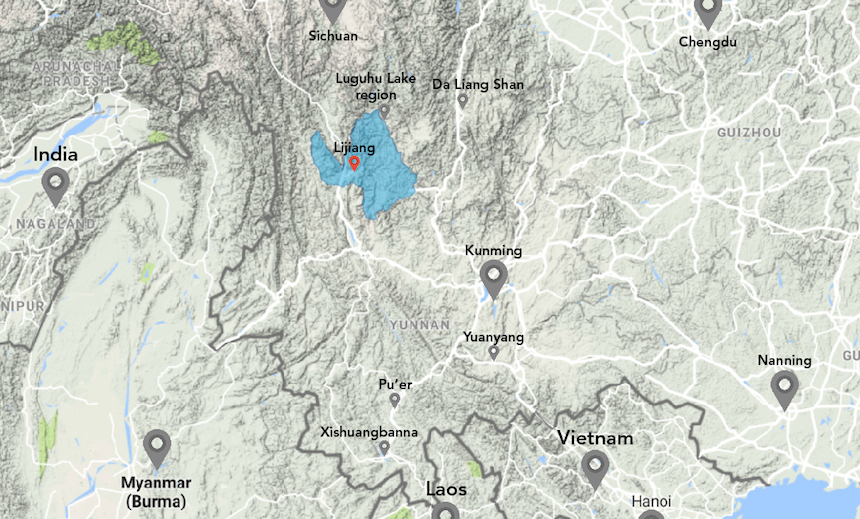
By Yves Tiberghien and Yvonne Xiao Tiberghien
Lijiang in the northwest of Yunnan province has got to be China’s most enchanting city. Sitting at 2,500 metres in elevation in an unspoiled environment beneath the majestic snowy peak of Yuelong Xue Shan (玉龙雪山, the Jade Dragon Snow Mountain, elevation 5,600 m), it is one of the best preserved ancient cities in the country. A UNESCO World Heritage town since 1997, Lijiang boasts cobble-stone bridges and roads, charming ancient buildings, and clean water canals that make it look like Bruges or Venice.
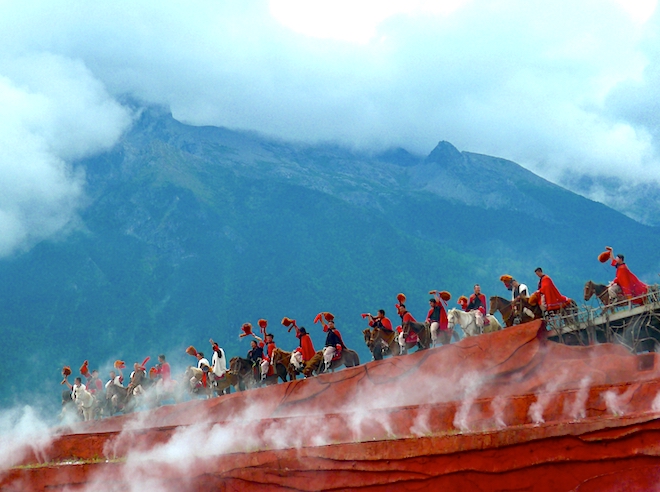
A cultural show depicting the history of the Tea and Horse Road in Lijiang, Yunnan province (beneath the Yuelong Xue Shan, or Jade Dragon Snow Mountain).
Even more remarkably, the city has become a centre of sorts for a culture of life-appreciation, which includes peacefulness, music, tea-drinking, healthy food, and simple living. The modern Lijiang culture is summarized by three words that are prominently displayed all over town, including in its shops, quaint inns, and cafes: fadai (发呆), which can be translated here as day-dreaming and chilling out; liaotian (聊天), or chit-chatting; and dawang (打望), or looking at beautiful girls and boys in the streets. Lijiang is a city where people fall in love and come to shoot their marriage photos or celebrate anniversaries. Shuhe, one of Lijiang’s smaller – and even cuter – neighbouring towns, has become alive with small art studios, tea shops, and artisan cafes, as well as music bars. A dominant, care-free folk music culture has sprung up on this high mountain valley mixing Naxi, Tibetan, and Yi influences with mainstream Chinese songs. Lijiang is also clean and at the vanguard of an effort to develop more ecological tourism, within limits of course.
However, venture out a few steps beyond the city’s last hillside temple and you will uncover the true secret of Lijiang: an ancient, well-polished stone road that seems to lead deep into the infinite mountain landscape. For, indeed, Lijiang grew into such a prominent city because of its central position on the ancient Tea and Horse Road (茶马古道), the most daring and rugged road on the planet. Growing out of a myriad of local trade routes, it came to be known as the Southwest Silk Road (西南丝绸之路). Since the early Tang Dynasty more than 1,300 years ago, that 3,000-km-long road crossed the most impenetrable river gorges of Asia and high Tibetan mountains to link Yunnan with Tibet, India, Burma, Vietnam, Laos, Thailand, and other parts of China. As we ventured beyond the hills of Shuhe and through bushes and grasses, we suddenly faced this mighty and improbable history. Why did human beings endure the toughest travel on earth to carry wheels of Pu’er tea into the heart of Tibet and other regions of Asia, risking death and leaving their families for years at a time?
Lijiang was also the heartland of the Naxi people, an Indigenous people who are thought to have migrated from the Northern Tibetan plateau and had their own system of writing (with vivid pictograms) and dongba religion (influenced by Buddhism). Joseph Rock and Peter Goullart wrote books about their culture and beliefs in the early 20th century, introducing the Naxi to the Western world for the first time.
Remarkably, Lijiang is also wonderfully well-preserved, spared from destruction during the Ming-Qing transition, the massive Muslim revolt of the second half of the 20th century, and the Sino-Japanese battles of the Second World War (which destroyed another ancient hub city on the Tea and Horse Road, Tengchong,腾冲).
We spent time in Lijiang both in June 2015 and September 2017, seeking inspiration into the origins of the Tea and Horse Road, as well as the challenges of modernity for people who have lived in these rugged but magnificent regions for thousands of years.
The original Tea and Horse Road is now gone, replaced in some sections by modern transportation infrastructure. In other areas, nothing is left but scraps of old pavement that would have echoed with hoof falls and the cries of brave muleteers in the cliffs above the Lancang River (澜沧江). But it gradually dawned upon us that the powerful spirit of this centuries-old road is indeed alive and well – and it is this very spirit that young urban people from around China and beyond come in search of. It is a cosmopolitan spirit of exchange, encounter, and dialogue across cultures and across faraway lands. The Tea and Horse Road connected Buddhist Tibetan people with Han Chinese, Hui Muslims, Mongols and their descendants, Indians, Vietnamese, Burmese, and numerous groups of mountain people in Yunnan and from other border regions. It was a human feat of determination across forbidding landscape that carried precious goods by mule along this road. Yet, it was also a great conduit for human connectivity and dialogue. Cultures and religions shared ideas on the human condition and intermingled through that road – may we call this hybridization? The relaxed and open-minded atmosphere of Lijiang encourages dialogue, friendship, and love. To us, it is reminiscent of the old cosmopolitan spirit of Chang’An, the capital of the Tang Dynasty (618-907 AD) and hub of the well-known Silk Road.[1]
Echoes of History
Yunnan has always been a frontier area, traversed by crisscrossing forces of history. The Tibetan Tubo forces invaded from the North in the 6th century AD. Kublai Khan’s Mongol invasion improbably came all the way across vast spaces and mountains and invaded Yunnan in 1253. In fact, his Northern Army camped in what is now Lijiang and crossed the Yangtze River near this spot on its way to attack the Kingdom of Dali. Since the Naxi people helped Kublai, he later invested their chieftain, the head of the Mu family, with local authority, an authority that lasted for hundreds of years, until 1730. After 1730, Qing bureaucrats took over the governance of Lijiang.[2] It is still possible today to visit the original Mu home in the old town of Shuhe (束河) and to contemplate the ancient fruit trees in the yards that separate the official rooms where the Mu lord officiated. Under able Mu leadership and their Qing bureaucratic successors after 1730, as well as due to sheer geographical luck, the Naxi people mostly succeeded in staying out of subsequent invasions and battles. The various French expeditions of the late 19th century, such as the 1867-1869 Mekong Expedition, focused on the Lancang (澜沧江) River and later the Red River in Southern Yunnan. They reached important cities of the Tea and Horse Road, such as Simao (思茅), Jiangcheng (江城), and Jianshui(建水), but did not make it to Lijiang.[3]
A tea shop in Suhe village sells traditional rolls of pu'er tea.
What made Lijiang wealthy and special, of course, is the Tea and Horse Road. The intimate connection between Tibetan culture and tea appears to have started when the Tibetan Tubo Empire conquered Dali in 704 AD, tea soon finding a sweet spot in Tibetan medicine and later Tibetan diet.[4] Its significance was enshrined in the famous story of the Tang Princess Wencheng who was sent on a two-year-long caravan journey from Chang’An to Lhasa to marry the Tibetan King, Songtsen Gambo in 741 AD with a dowry of many tea leaves. As Canadian explorer, mountaineer, and writer Jeff Fuchs aptly puts it: “The union of the Tubo king and the Tang princess ushered in a brief period of peace, and unending period of tea.”[5] As tea became an indispensable balancer and tonic in Tibetan diet, it turned into a great “bargaining chip” and instrument of political control for the Tang Dynasty in its relations with the Tibetan kingdom. It spurred a boom in Pu’er tea plantations in Yunnan, including the province’s famed century-old tea trees and a formalization of the great road to Tibet. In turn, the road became a conduit to bring prized Tibetan war horses to China in an effort to strengthen its defences against the Northern Mongols. This symbiotic trade became so valued that the Song Dynasty formalized it through the Tea and Horse Trading Bureau.[6] Year after year, century after century, thousands of mule convoys led by rugged Tibetan, Naxi, or Muslim Hui muleteers, and thousands of labourers each carrying 100 kilos of tea cakes, have treaded the treacherous stone pathways hanging on cliffs and cross thunderous rivers on tiny suspended bridges.
Over the centuries, the road spun many new branches, down to India, across to Burma (and the Shan states), down to South East Asia, and across Sichuan, Yunnan, and Guizhou. In fact, Yvonne’s hometown, Xichang, was a hub on one such side road, and her family operated a big inn on the road, where muleteers and merchants could rest and stock up on supplies. Along the way, these travelling traders brought rare goods and shared stories from faraway regions and cultures that enchanted Yvonne’s family. They also shared scary stories of brigands that ambushed the caravans along the way.
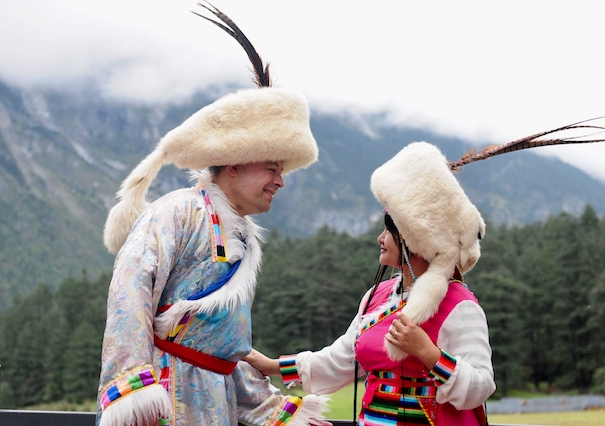
Authors Yves and Yvonne, dressed as Tibetans who have traditionally traded along the Tea and Horse Road.
For a city like Xichang or Lijiang, to be connected on this long, improbable road meant access to distant news and exotic products. It also opened up the minds of children and residents to astonishing, remote worlds to a myriad of different, exotic cultures. Over the mountains and across the gorges, the road transmitted new thoughts and possibilities. It carved a spirit of adventure and broadened the imagination. Over the centuries, the road ebbed and flowed with the relative strengths of empires and the pulse of Tibetan-Chinese relations, but it somehow endured.
An entrepreneurial revival
Lijiang is a city of cultural exchange, hybrid culture, and human encounters. We had some memorable encounters of our own with local Naxi people while buying fruit or local cloth. A young Naxi man taught us quite a few characters in the vivid Naxi script and meticulously explained to us the meaning of each word. And yet, it is now difficult to learn authentically about Naxi culture in modern Lijiang, since over 90 per cent of the original inhabitants have sold their homes in the city, either because repairing their damaged houses after the 1996 earthquake was too costly, or simply because the inflow of tourism and notoriety has made Lijiang itself too expensive. Instead, Lijiang has become a magnet for individuals or entrepreneurs from around China in search of a new life. The majority of beautiful courtyard homes have been turned into gites, French or Swiss-style holiday-home rentals, as well as cafes and restaurants. Most of them are small in scale and individually run, embellishing the original Naxi flavour and keeping to the general spirit of the city.
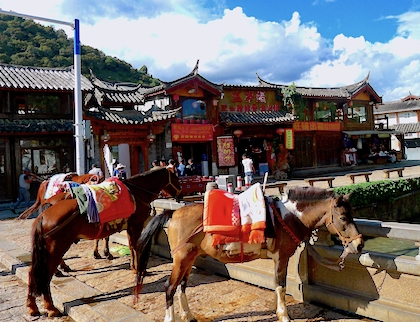
Eco-tourism has taken hold in Lijiang – but not always to the benefit of the original inhabitants.
We recall a vivid conversation with an entrepreneur who had left Northeast China fifteen years earlier for the dream of living in beautiful Lijiang. She took over an old house and turned into an open inn arranged around a flowered courtyard where she serves tea and coffee. She shared in the transformation of Lijiang over the past 15 years, with more and more people searching for that free and clean environment. Her daughter took on the wild frontier spirit and became a motorcycle enthusiast, riding on her own the endless road to Tibet and tasting a whole new life.
Enter the visionaries
In Shuhe, we found a very special space with another rare entrepreneur and became good friends. Mr. Wu, a former rock singer from Northern China, dreamt of living in Yunnan and starting something unique. In a city famous for tea, he decided to take on the cause of coffee and to create a garden coffee shop dedicated to the appreciation of local Yunnan coffee. Mr. Wu stumbled upon the history of the very first coffee plantation in a remote Yi area of Yunnan near Lijiang in the early 1900s. Nowadays, Chinese people believe that this plantation was started by a French missionary from the Paris Foreign Mission (MEP) in the village of Zhukula, Binchuan county, Dali prefecture (大理宾川县,大理州). Yi people in the countryside came to ask the missionary to help some Yi folks being mistreated by a landlord and he agreed to support them and testify in their favour in court. With his support, they won their case and the local Yi people came to trust the missionary. They invited him to live in the village. As he discovered their state of poverty and limited food production, he apparently suggested to them to start growing a more profitable crop: coffee. Thanks to his connections with the French authorities and coffee growers in northern Vietnam, the missionary apparently brought some plants to Binchuan county and local coffee started in Yunnan in this most unlikely way.
Mr. Wu dedicated his coffee shop to this missionary and created a little shrine in his honour on the walls of that coffee shop. When we visited in 2015, he only had the Chinese name: 田德能 (Tian DeNeng). We later contacted the headquarters of the MEP in Paris and found that his original French name was Alfred Liétard, the priest who came to settle in the land of the Lolopo between Dali and the Jinsha River and who later wrote a well-known account of the life, culture, and language of the Lolopo people. Stevan Harrell refers to him in his book.[7] We shared our finding with our friend Mr. Wu by WeChat. When we returned in 2017, he had expanded the shrine and added the French name and details on the priest’s childhood and life in France and later in Yunnan.
Mr. Wu’s coffee-shop dream combines a true dedication to high-quality coffee, including the use of old French drip pots, with an appreciation of local production. He visits the Binchuan region, where he buys his coffee from the Yi people and collects memories of Alfred Liétard. This story may not be about the Tea and Horse Road specifically, but it encapsulates the same spirit: a spirit of cross-cultural hybridization and exchange, combined a great appreciation for quality flavours and slow food, which strives to preserve traditional and regional cuisine and encourages farming in synch with the local ecosystem. His coffee shop would fit right in with the slow food movement, with its beautiful garden, quaint tables in an old house, and fleeting butterflies. Yet, it also encapsulates an ancient human encounter in a remote Indigenous mountain and brings its memory back to our day. This remains our favorite spot in Shuhe!
Just outside Shuhe, in the sleepy ancient village of Baisha (白沙), another entrepreneur has fulfilled a dream combining art and connection with local Indigenous people. Master Pengping is a native of Sichuan and a master of the exquisite Tangka[8] silk embroidery of China. Her work was displayed around the country and China Post even produced a stamp with her art work. Master Pengping chose to settle in the village of Baisha with her husband and to develop a large workshop and beautiful shop. She employs dozens of local Naxi girls, teaching them the art of embroidery and encouraging them to develop their own art and to sell their best work to make a living. The shop is also a museum with all the best creations by Master Pengping, radiating a feeling of peace and harmony. This is a traditional Chinese art form, yet it is also infused with the natural and human beauty of the land of Lijiang. Amazingly, Pengping is a classmate of Yvonne’s from Chongqing and she once studied English language and literature, before finding her true calling.
These stories summarize the continuing role of Lijiang as a place for entrepreneurial dreams and encounters.
Modern policy questions
Emerging in the 1990s as a rediscovered and preserved ancient town in the midst of the beautiful Himalayas, Lijiang has experienced very rapid changes and some new paradoxes. It lies at the heart of the ancient Tea and Horse Road but may well emerge as a new place of appreciation for coffee. It celebrates the cultural treasures of the Naxi people, yet few Naxi people remain in today’s Lijiang, pushed out by high prices and economic realities. Lijiang also makes a good job educating visitors about the importance of ecological and biodiversity protection, offering a very clean city with clean air and clear rivers. The protected park in Yulong Xue Shan appears well managed, with very clearly marked boardwalks that are well respected. Within the city, large posters show that the Naxi were truly advanced in the management of clean water in the canals that traversed their cities. Yet, Lijiang’s beauty is gradually attracting flows of tourists from all major cities in China and the middle class is lining up to buy real estate that is blossoming up around Lijiang’s old town. Will the delicate balance hold?
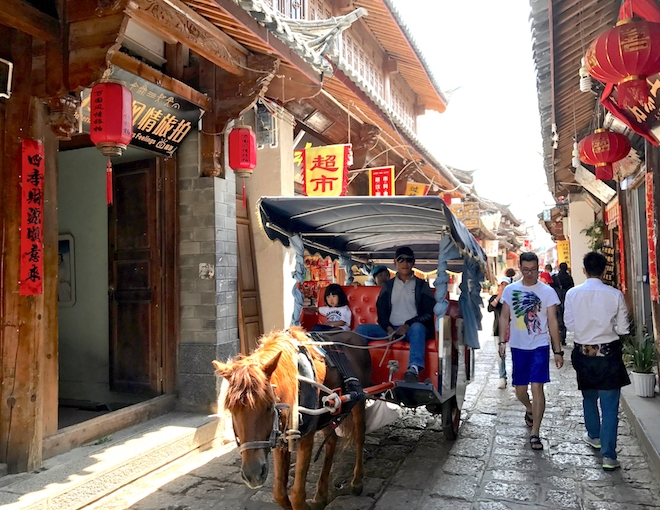
An old Lijiang city street at the heart of the ancient Tea and Horse Road.
All over Lijiang and Shuhe, traditional local products such as rose petal cakes (鲜花饼) and fruit wines have become very popular tourist souvenirs. In this day and age, the great majority of purchases are made as cashless payments with WeChat or Alipay and are directly shipped around China through the hyper-efficient systems of fast delivery (kuaidi, 快递). Every evening, mountains of kuaidi are piled up in front of all the shops and small vehicles come and pick them up. Yet, while these precious goods originate with local Naxi people, the trade is now mostly in the hands of Chinese entrepreneurs. There lies one area for improvement: developing an eco-tourist industry where the benefits from cultural creation can genuinely benefit the original Indigenous people who were at its origin, in the spirit of the Nagoya Protocol.
Lijiang is a city of legends and the heart of the mythical Tea and Horse Road. It is the gateway to impenetrable gorges and snowy peaks and it has been called the “Venice of the Himalayas.” Naturally, the road that sealed the peace between the Tang Dynasty and the Tibetan kingdom is now gone, but it has left behind a cosmopolitan, adventurous, and artistic spirit that is alive with human energies. Lijiang is a hybrid place with many roads leading in many directions. The ancient, fearless spirit of the road lies deeply in the hearts and minds of modern people here, both the original Naxis, Yi, Tibetans, Hui, and Dai people, but also the new generation of young Chinese entrepreneurs who came here for that very spirit.
Lijiang is a story of human encounter, a fusion of many dreams, and a city in our hearts. If you visit Lijiang and its surrounding, be ready for sparks to fly.
[1] For a wonderful depiction of the human dynamics of the Tang Dynasty, see Mark Edward Lewis. 2009. China’s Cosmopolitan Empire: The Tang Dynasty. Cambridge: Harvard University Press. On the Silk Road itself and its many meanings and many stages, see the classic Peter Frankopian. 2015. The Silk Roads: A New History of the World. New York City: Vintage Books.
[2] See Goodman, Jim. 2009. Yunnan: South of the Clouds. Hong Kong: Odyssey Books. Pp. 339-342.
[3] For the narrative of that daring expedition, see Garnier, Francis. 1873. Voyage d'exploration en Indo-Chine par une commission française. Paris: Hachette.
[4] See Freeman, Michael and Selea Ahmed. 2015. Tea Horse Road: China’s Ancient Trade Road to Tibet. Bangkok: River books. Pp. 68-69.
[5] Fuchs, Jeff. 2008. The Ancient Tea Horse Road: Travels with the Last of the Himalayan Muleteers. Toronto: Penguin. P.5.
[6] Freeman and Ahmed. Op Cit. p.2.
[7] Harrell, Stevan, ed. 1995. Cultural Encounters on China’s Ethnic Frontiers. Seattle and London: University of Washington Press. Pp. 69-70.
[8] https://en.wikipedia.org/wiki/Thangka
Chapter Four: Exploring China’s Conservation Efforts in Yunnan Province +
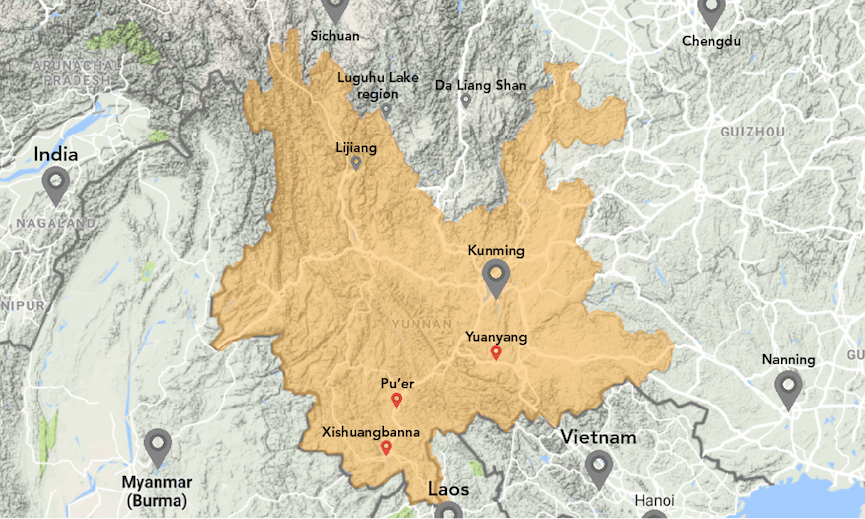
By Li Guo, Yves Tiberghien, Yvonne Xiao Tiberghien, and Dayuan Xue
It was a beautiful evening in late May 2015 when we arrived in remote Xinjie Town, Yuanyang County (元阳县,新街镇), in the heart of Yunnan Province’s Ailao Mountains, close to China’s border with Vietnam. That day we had flown from Beijing to Kunming and driven for more than seven hours across treacherous mountain roads and across the gorge of the mighty Red River (红河, or Hong He). The last two hours of driving took us from the Red River (at nearly 200 metres of elevation) all the way to 1600 metres of elevation across really dramatic geography. This has long been a remote settlement, where the Hani people (and some Yi, Dai, Miao, Yao, Zhuang, and Han people) have lived for more than 1,300 years in relative isolation.
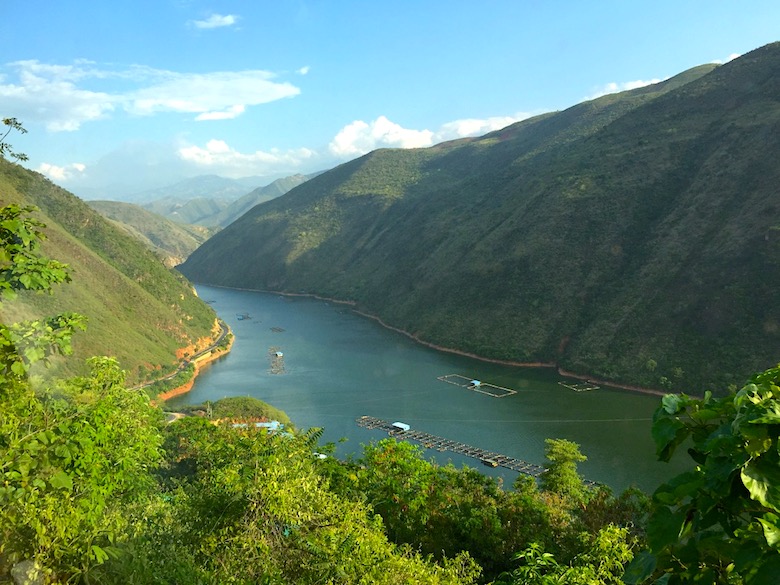
On Day 1 of the expedition, the team finally reaches the steep gorges of Red River, before climbing into the mountains on the other side.
And yet, as we took a walk through town at dusk and came across the beautiful central square, we witnessed a scene that appeared to be a mirage. This polished square overlooking vertical cliffs and a string of rice fields all the way down toward the gorge of the Red River was awash with the light of sunset and a magical breeze. It came alive with people of all ages in brightly coloured clothes and cheerful music. Soon, the whole village appeared to have joined in a carefree evening square dance, as if in complete union with the magnificent landscape. On top of the mountains, Hani children were playing, parents were dancing, and grandparents were chattering away. Even birds and the mountain wind joined in this evening harmony. This unlikely scene was one of the most memorable images of our trip. It also reminded us that ecological protection in China is first and foremost about the balance between nature and people. It is as much about pollution control as it is about the recognition of the age-old livelihoods and traditional knowledge of the Indigenous peoples who have settled the most remote regions of China. The first necessary step, therefore, is to sit down and listen to the voices of Indigenous people who have accumulated so much human experience in their interactions with the natural landscape, and also have much to share about the precarious human struggle on these high mountain slopes.
That evening was the start of our 10-day joint learning mission with a group of environmental and social scientists from China and Canada. Professor Xue Dayuan, from the College of Life and Environmental Sciences at Minzu University of China (MUC), led our team. Other members included Dr. Wu Jianyong (Nanjing Institute of Environmental Science, under China's Ministry of Environmental Protection), UBC Ph.D. candidate Guo Li (a specialist in China’s environmental policy), Master’s student Piao Jinli (MUC), as well as Yvonne and Yves.
The research mission was part of a Chinese effort to document and protect biodiversity and associated traditional knowledge (such as agricultural practices and traditional medicine) of China’s remote areas. This research supports the implementation of the UN Nagoya Protocol on Access to Genetic Resources and the Fair and Equitable Sharing of Benefits Arising from their Utilization to the Convention on Biological Diversity, which China signed in 2010 and ratified in 2016 (but was not signed by Canada). The Nagoya Protocol not only requires that genetic resources and associated traditional knowledge be protected, but it also calls for equitable benefit-sharing from such genetic and traditional knowledge resources with the providers (original owners and inhabitants, mostly Indigenous people). Chinese researchers are therefore interested in evaluating early experiments in protection and benefit-sharing across pilot areas and in gradually developing best practices. In the process, they hope to help protect ecological and human heritage – but they also hope to find ways to do so that improves the livelihood of Indigenous people who live in these areas and who have developed this knowledge over centuries.
This work is extremely important, as China is one of the planet’s richest countries in terms of biodiversity. According to the site Mongabay.com, a respected independent organization dedicated to environmental science and forest conservation, China ranks #4 in the world, in terms of quantity and diversity of existing biodiversity, after Brazil, Colombia, and Indonesia, and just ahead of Mexico, Peru, and India.[1] The Yunnan Province is connected to a broader reservoir of biodiversity and human traditional knowledge in the whole lower Himalayan mountain region that spans several countries. According to Professor Xue Dayuan’s research, China is home to over 35,000 original higher plants and 6,445 vertebrate animal species (14% of world animals). China is also the country of origin for many crops such as rice, soybeans, and wild and cultivated fruit trees. Within China, people have experimented with traditional living and cultivation styles for millennia, and this includes the cumulative experience of a large number of traditional people (now formally classified as 56 ethnic groups, of which 55 are minorities). China has increasingly worked to play a role in co-developing and adopting UN standards on biodiversity, including the Convention on Biological Diversity (CBD, 1992), the Cartagena Protocol (ratified in 2005), and the Nagoya Protocol (ratified in 2016).[2] The forest cover, for example, has started to recover in China (increasing from 16.7% in 1990 to 21.9% in 2010). Protected areas have increased from 13.05% to 16.10% in the same period. The 16% amount in 2010 compares well with 9% in Indonesia, 6% in Myanmar, and 5% in Vietnam.[3]
Over a ten-day period, our team would travel across distinct and rich eco-systems in Yunnan, from the Ailao Mountain inhabited by the Hani people, to the remote national nature reserve of Naban River (纳板河) in Xishuangbanna (西双版纳) Autonomous Prefecture, the Xishuangbanna Tropical Botanical Garden run by the Chinese Academy of Sciences in Menglun Town, Mengla County (勐腊县 勐仑镇), and the Wild Elephant Valley National Park in Menyang (勐养)Nature Reserve. Along the way, we would also meet a series of traditional ethnic Hani, Dai, and Yi doctors in their clinics in Pu’er and Xishuangbanna, engaging in fascinating conversations. In every site and village, we had the support of local experts and scholars and were able to engage in long conversations with village leaders and other villagers. In closing, we visited a well-known and effective non-profit organization, the Center for Biodiversity and Indigenous Knowledge (CBIK) in Kunming.
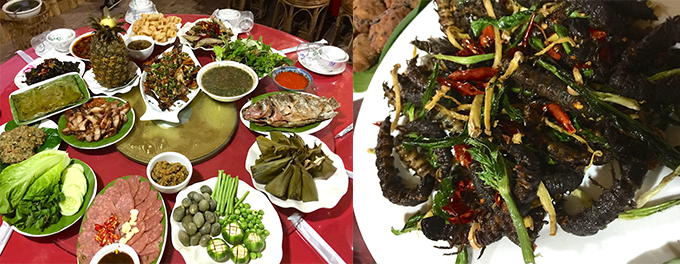
A delicious traditional Dai dinner in Xishuangbanna with local wild vegetables and yummy fried scorpions!
During our many natural site visits and conversations with local Indigenous people, we were deeply impressed by the extent of natural beauty and human knowledge in the province of Yunnan. As in many other high biodiversity areas of Asia and beyond, local people developed ways of life highly integrated with the natural environment, from which we have much to learn today. The challenge for China and other countries is indeed to find ways to protect these treasures and to find effective ways to support improved well-being for local people as access to these remote areas is widened.
Meanwhile, if we honestly poll each member of the team about their best memories from the visit, all would probably acknowledge that it was the meals we shared with each ethnic community. Hani and Dai dishes, enjoyed under the natural canopy with the villagers, is incredibly rich in flavours, plants, and spices that North Americans can only dream of. Long discussions around the dinner tables, as guests of our Hani and Dai hosts, were the true blessings of our trip. For this, we dedicate this blog to all our friends in Yunnan and hope to visit them soon again.
The Magnificent Honghe Hani Rice Terraces
It is hard to understate the awesome sight of 3,000 rice terraces stretched from the height of the Ailao Mountains (at nearly 3,000 metres) down to the Red River, all carved out of a rugged mountain landscape by the Hani people over some 1,300 years! Watching the sunset reflecting into the myriad ponds over the mountains is like witnessing multicolor sparking diamonds echoing across the terrain.
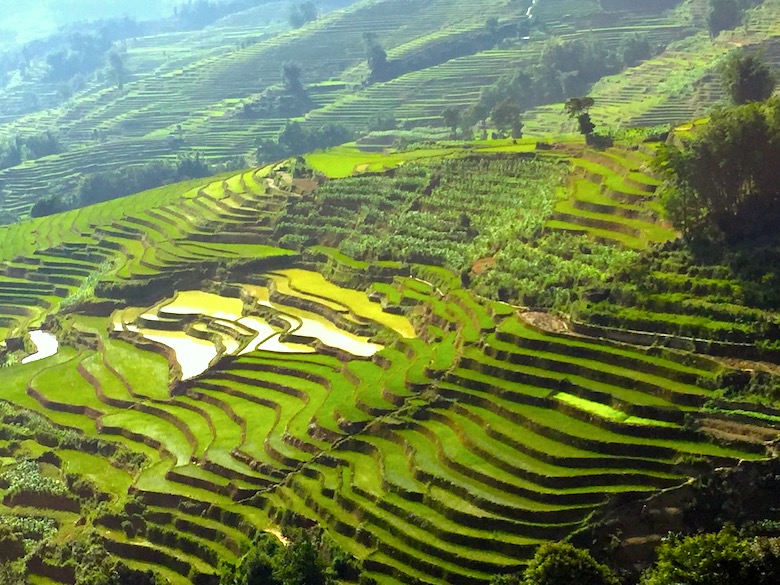
The spectacular Yuanyang rice terraces, carved and curated over some 1,300 years, on an early summer morning.
Even more impressive is the fact that, over the centuries, the Hani succeeded in developing a sustainable integrated farming system, channeling water from the mountaintops down to the terraces, and cultivating fish and eel in the ponds, alongside their rice. When this remarkable site was accepted as a UNESCO World Heritage Site in 2013, UNESCO noted: “The resilient land management system of the rice terraces demonstrates extraordinary harmony between people and their environment, both visually and ecologically, based on exceptional and long-standing social and religious structures.”[4] Interestingly, while the terraces span the length of the mountain range, the 82 villages are all clustered in a similar band around 1,500 metres of altitude.
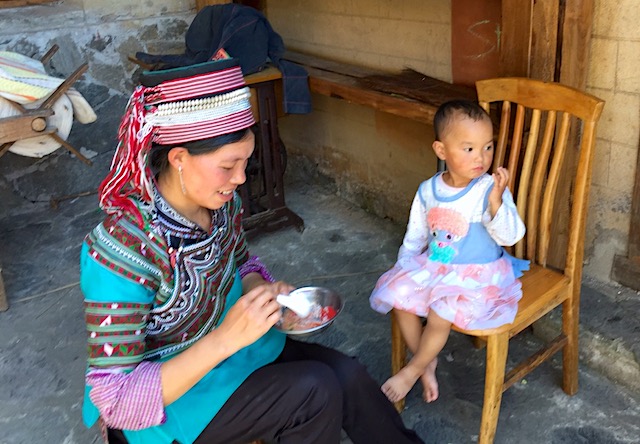
A Hani mother and child in a demonstration folk village (Qingkou Minshu Cun) in the heart of the Yuanyang protected rice terrace zone.
In light of the growing tourist attractiveness caused by the UNESCO label and the likely future opening of easier transportation, how is China ensuring that openness still allows for the protection of this age-old heritage and benefits the local Hani people who developed it? Our research shows some success on the first dimension (protection), but mixed results on the benefit-sharing side of things.
On the government side of things, a new authority was created to co-ordinate between provincial, prefectural, and county levels (both Honghe and Yuanyang counties): the Hani Rice Terraces Management Committee. This Committee has created strict rules to ensure the protection of both the natural and the human environment and is super imposed to local customary rules. However, as prefectures and counties lacked any funding to further develop the area, they hired an outside company to develop the touristic potential of the Hani terraces. The company committed to invest significantly in developing the area and to hire local people as guides at decent wages in exchange for keeping 75 per cent of revenues from ticket sales. It turns over the other 25 per cent to the villages. However, this arrangement has led to several complaints by the villagers we met. First, local villagers clearly wish for more direct participation and responsibility in the protection of the heritage developed by their ancestors. They resent the power of the company over the community. Second, they feel that the revenue-sharing agreement is not balanced, especially as the company has not invested as much as promised in the community. For example, villagers feel that the 10 RMB (approximately C$2) annual bonus they are paid to keep villages clean for visiting tourists is not a fair share. Third, they shared with us their frustrations with some of tight rules imposed on their ability to modify their homes or villages (quite similar to home renovations in protected areas in many countries), when new real estate developments by outside developers are given the green light.
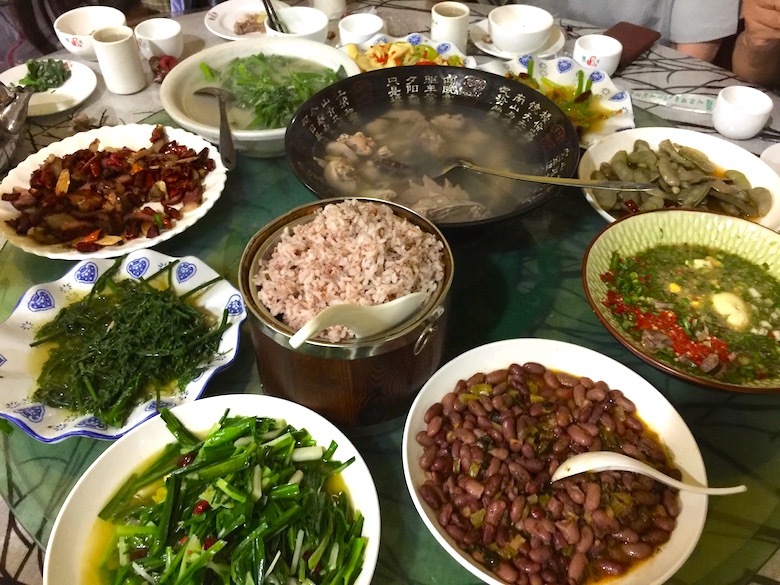
The research team enjoys a delicious dinner of self-selected local vegetables and meat in a traditional Hani restaurant in Xinjie town, atop the protected Yuanyang terrace fields.
These questions are emblematic of the difficult transition from a remote traditional village area to an area of modern tourism. Large economic potential attracts outside interests and the government (mainly at prefectural or county levels) ends up being the referee of benefit sharing. Finding mechanisms to enhance the voice and participation of local Indigenous people in key decision-making must be a priority.
No outside visitor can leave these Hani rice terraces without a sense of awe for the centuries of human creativity and labour that have enabled a community to carve out such an integrated farming system in symbiosis with a formidable natural environment.
An Experiment in Co-Management: The Nabanhe National Nature Reserve
The Nabanhe Nature Reserve outside Xishuanbanna protects a small river watershed ecosystem. It includes pristine mountains and river environments. It is also the home for over 5,000 people from five ethnic groups: Dai, Lahu, Aini, Bulang, and Yi. It is a remote and poor area, and our expedition leader Professor Xue insisted that we should spend a night sleeping in those remote mountains (with their assortment of insects and snakes) to be properly trained as natural researchers. In the end, he did not enforce this requirement and we remained bite-free but also less educated by the friendly bugs! We did, however, spend a day exploring the furthest corners of this reserve, along with the local villages.
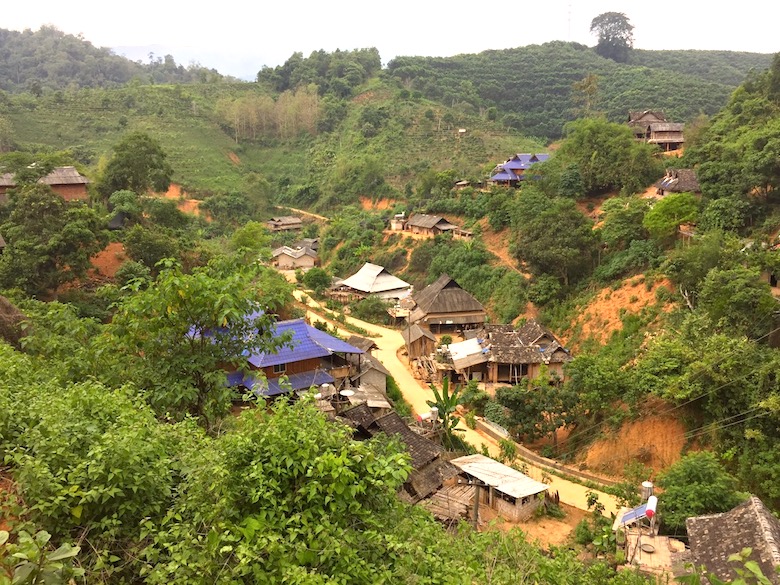
A remote Dai ethnic village in the Nabanhe Nature Reserve, featuring traditional wood houses alongside a few modern homes supported by the environmental protection funds.
Nabanhe is special as a pilot reserve directly run by China’s Ministry of Environment Protection (MEP) (and not the Forestry administration). It is also special since the MEP follows a governance model where no new administrative level is created, relying instead on co-management with village leaders. The model does involve nudging people to relocate from the most environmentally sensitive areas and avoiding practices that are detrimental to the eco-system. This takes a lot of work and finding new benefits that can improve the livelihood of local people.
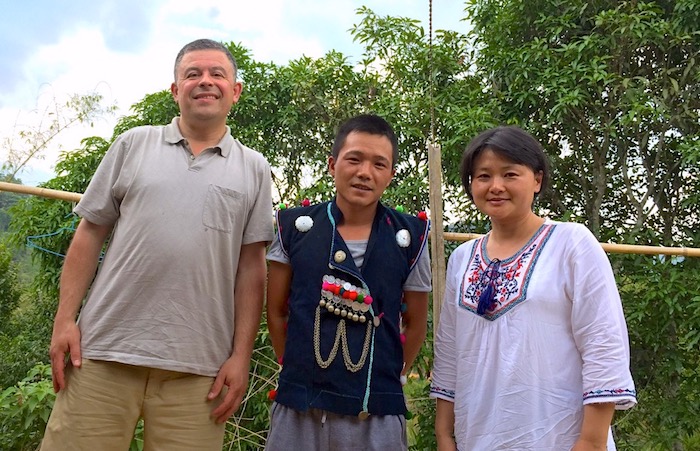
Yvonne and Yves with the young chief of a Dai ethnic village in the heart of the protected Nabanhe Natural Reserve, discussing the new road that just reached the village.
For the nature officers sent by the MEP, this is rewarding but extremely hard work. In part due to a history of past conflicts – including the deployment of outside Red Guards during the Cultural Revolution – local people were at first extremely reluctant to allow new outsiders to come and settle in their midst with new rules and regulations. Over one late dinner, one officer recalled how local people first threw him into a pig barn for three days. His patience and understanding of the hardships of local people eventually paid out and he earned the trust of local villagers.
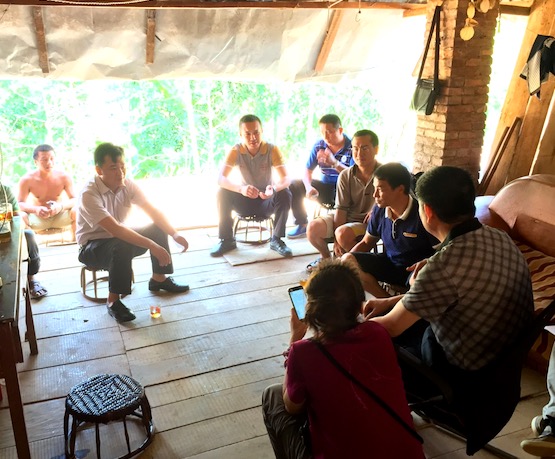
The research team interviews the village leader (Dai ethnic group) in his home with his family members, along with the local environment protection team.
In several villages, we witnessed the result of this partnership. Outside resources brought new installations and tools, while villagers serve as patrol crews. Together, they are able to develop local plant nurseries and support the regrowth of depleted areas. However, these outside resources brought by the MEP are not sufficient to support the livelihood of local people. In the end, whatever the wishes of the MEP officers, the locals cannot afford to give up the plantations of rubber, or even worse, bananas (based on the fluctuations of commodity prices) that have a negative impact on the nature reserves.
The Nabanhe Reserve was a wonderful chance to learn of the ongoing effort to protect biodiversity in China, but also its struggles. No success can be achieved without working together with the local Indigenous people who have lived in those ecosystems to develop a pathway that improves their livelihood while protecting nature. It takes a long-term co-operative strategy. We are grateful for the long conversations at twilight with a young Dai village leader, who was generous enough to welcome us into his family home, along with county and prefectural leaders for a dinner of local dishes.
Nearby, we also visited the central government-funded Xishuangbanna Tropical Botanical Garden and its dedicated team of researchers. The garden itself is a wonderful eco-system that includes thousands of rare species and has recreated a complete South East Asian jungle environment. It is connected to a global network of similar botanical gardens in South East Asia, including nearby Myanmar and Thailand. What remains to be developed is a proper system of compensation and benefit-sharing with local people who played a key role in nurturing and protecting tropical plants with agricultural or medicinal values over millennia.
A Bone-Cracking Foray into Indigenous Traditional Medicine
In Pu’er and Xishuangbanna, our team also focused on learning about traditional medicine and traditional doctors, particularly in the Hani and Dai communities. Our conversations with several well-respected doctors at the heart of the communities revealed the extent of their knowledge and stores of medicinal plants. By studying our hands, faces, and heads, these doctors could reliably identify our overall health and mental states, and the quality of our inner energy flows. We found those assessments remarkably accurate. One Hani chiropractor doctor in Pu’er had also invented some medicinal beverages. Despite his small size and unassuming demeanor, he could literally suddenly lift Yves up on top of his back and rearrange all the bones in his body, before sharing a traditional glass of Hani herb medicine. Yves felt much better for the experience, especially after also sharing dinner and many glasses of mao-tai with the doctor. A special wine spray containing infused Chinese medicine and invented by a close friend of this Hani doctor proved so effective that Yvonne is still using it today as the best remedy against seasonal eczema.
 Crack! A well-respected traditional Hani Doctor in Pu'er city (Dr. Chen Hong Bao) fixes Yves up, after examining his overall energy flow.
Crack! A well-respected traditional Hani Doctor in Pu'er city (Dr. Chen Hong Bao) fixes Yves up, after examining his overall energy flow.
In fact, these medicinal traditions have been so well developed over centuries that Simao City has an entire herb market and several Hani traditional clinics. Pu’er City has also established the Pu’er National Institute of Ethnic Traditional Medicine, tracking centuries of discoveries.
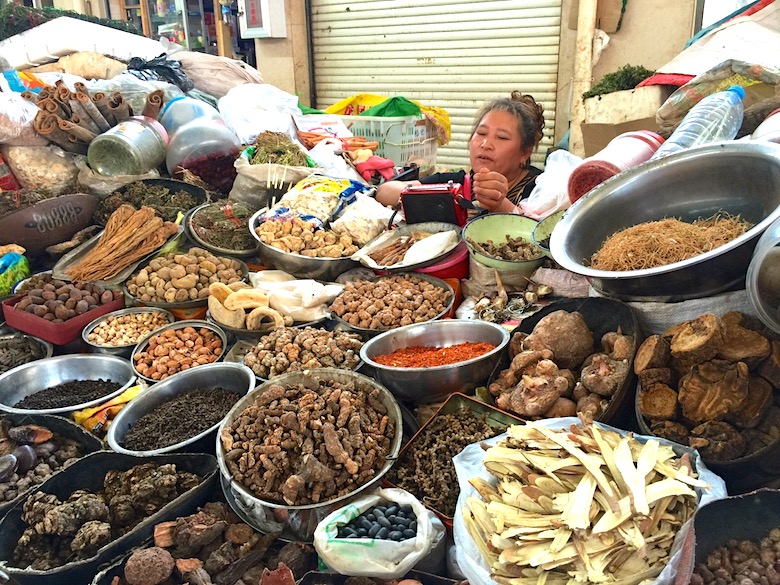
A traditional Pu'er Chinese medicine market, including many local ethnic herbs, roots, and insects.
Xishuangbanna has gone further and established a modern, full-scale Ethnic Dai Hospital in Jinhong City. The most impressive sight was something that resembled a small space ship out of Star Wars, where patients can be entirely ensconced into a sarcophagus of traditional Dai herbs and be completely cured from various chronic illnesses, such as arthritis, after a number of treatment sessions. The Dai community has also developed large books of traditional medicines over centuries.
The key now in the post-Nagoya world is not only to make such amazing discoveries available to more patients around the world, but also to fully compensate the inventors of these discoveries and ensure returns to the Dai community.
We left Yunnan utterly impressed by the extent of the natural and human treasures developed over a long history. The greatest discovery in this trip is how intertwined nature conservation is with the acknowledgement of the contribution of Indigenous people who have lived in these areas, and the necessity to develop better mechanisms to fully work with them and share all benefits arising from the conservation of biological resources, utilization of genetic resources and associated traditional knowledge, as well as customary practices. China has a long way to go in advancing these practices, although we also met impressive and dedicated teams of scientists and local leaders who are fully dedicated to the task at hand.
ENDNOTES
[1] Source: Mongabay.com, using IUCN and UNEP data, May 2016. https://news.mongabay.com/2016/05/top-10-biodiverse-countries/
[2] In order to fully implement these commitments, in 2010, China developed the China National Biodiversity Strategy and Action Plan (up to 2030), under Professor Xue Dayuan’s leadership and with the involvement and support of the Premier. In 2011, it created the National Biodiversity Conservation Commission.
[3] Source: Asian Development Bank. 2013. Report on Protected Areas in Asia. Appendix 7.
[4] Source: UNESCO, http://whc.unesco.org/en/list/1111.
